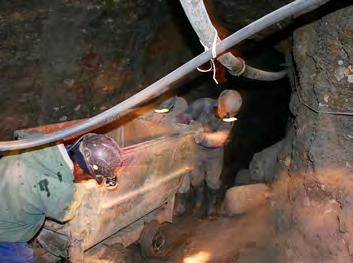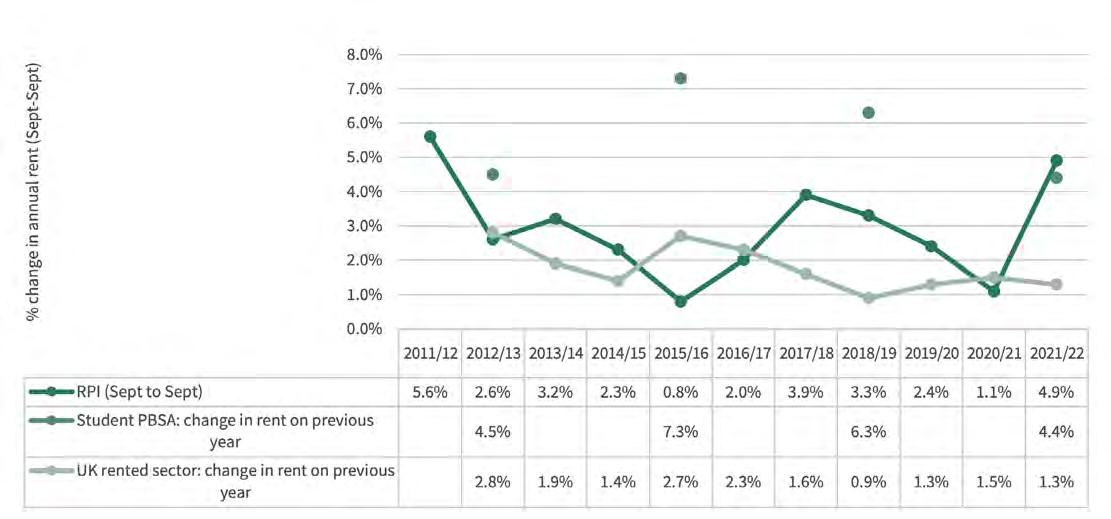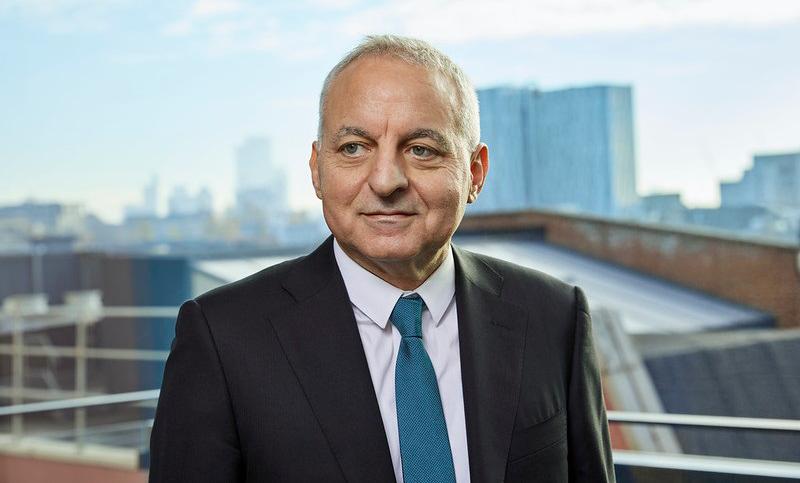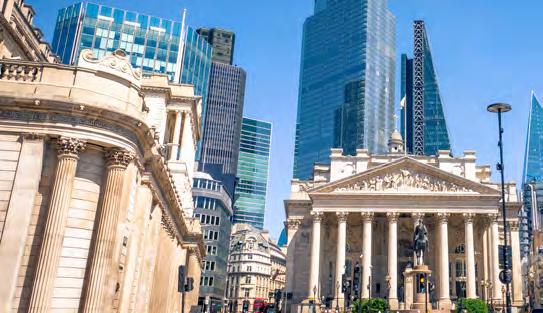Paying for university
The investment plan to help your children graduate without big debts
best ways

VOL 25 / ISSUE 09 / 09 MARCH 2023 / £4.49
xxxxxxxxxx The hot topics and the
to invest SOFTWARE SECTOR REPORT









• China’s new 5% growth target underwhelms as its focus shifts to boosting consumption
• Aston Martin shares jump the gun in rush for profitable growth
• Shaftesbury focused on income growth and cost cutting as it completes Capco merger
• ASOS shares gain 80% year-to-date on growing turnaround hopes
• Fresnillo suffers as costs surge and precious metals lose some shine
12 GREAT IDEAS New: Harmony Energy Income Trust / Medica Updates: Cheniere Energy
16 FEATURE Find out which companies are planning double-digit dividend increases
20 FEATURE Paying for university: The investment plan so your children graduate without big debts

28 SECTOR REPORT Investing in the software industry

33 UNDER THE BONNET How new boss Tufan Erginbilgic can transform the fortunes of Rolls-Royce
37 EDITOR’S VIEW The UK stock market indices have a crisis on their hands

38 RUSS MOULD Should investors seek exposure to the FTSE 100? Here are the pros and cons
42 FEATURE What is ‘the 4% rule’ and is it still relevant to investors today?
45 ASK TOM What are the rules around adding cash to a SIPP in capped drawdown?
47 PERSONAL FINANCE Building a £1 million tax-efficient portfolio for your children

50 INDEX Shares, funds, ETFs and investment trusts in this issue

Contents 06 NEWS
42 47 09 March 2023 | SHARES | 03
28 06 20
SectorReport:Thesoftwareindustry

inHowyoucaninvest
21stcompaniesstate-of-the-artpoweringthe Centuryeconomy
whyShareslooksatthesoftwareindustry, itissoimportantandwhoarethemajorplayers Isensethasbeendifficulttoignoretherenewed marketsofoptimismcreepingintostockthisyear.Miseryhasbeenreplaced byawatchfulbrightness,andnowherehas thissheenreflectedbetterthanamongsoftware growthstocks. US-listedAftertumblingmorethanathirdin2022,the iSharesExpandedTech-SoftwareSectorETF(IGV:BATS) comprisedofmanyofthemajor asenterprisesoftwareplayers,wasup16%thisyear writeof2February.Itremainsabout11%aheadaswe Thatthisfeature(2March).comparestotheNasdaqComposite’s10.4%FTSEgainandthe4.1%advanceoftheS&P500.The The100isabout5%ahead.macroeconomicandgeopoliticalanxietiesof rates,thepastfewyears–soaringinflation,risinginterest war,recession,etc.–arestillrampantand feedinvestorworriesaboutweakeningbusiness spendingthataredampeningforwardexpectations. SOFTWAREISINLOCKSTEPWITHINFLATION, RATESANDEARNINGS whatSoftwareisasectorthatwalksinlockstepwith happenswithinflation,ratehikes(particularlybytheUSFederalReserve)and2023earnings andguidance.‘Investorsremainfocusedonmacrocommentary report.ITspendingpatterns,’saidanRBCCapitalMarketresearchfirmGartnerinJanuarycut itsforecastforgrowthin2023globalinformation technologyspendingbymorethanhalfto2.4%, addingupto$4.49trillion.
compared‘InJanuary,wesawhigherscrutinyonbudgets toDecember,resultinginadditional anddelaysinlargedeals,’saidJayChaudhry,chairman chiefexecutiveofcloudsecuritybusinessZscaler(ZS:NASDAQ) atthebeginningof March2023. WoodButthereisoptimismtoo.CowenanalystDerrick enterpriserecentlysurveyedtechdepartmentsonsoftwarespendingpriorities.‘Oursurveyprojects7.3%budgetgrowthin2023,amodest decelerationfrom8.3%in2022,’hesaid. vendorsAshasbeenthecasewithmanysoftware businessesduringthelatestearningsseason,aretakingmoretimetoscrutinisedeal arelengthsorsubscriptions,andsoftwarecompanies streamliningtheirownoperations,aworryforthepaceofgrowththrough2023. Yetsoftwarepenetratesvirtuallyeveryaspect bothofourlivesinthedigitalinformationageand systemsindividualsandbusinessesrelyonoperating andapplicationsthatmakessoftwareascrucialasoil,glassandsteel. industryForexample,virtuallyeverycompanyinevery isnowlookingtousesoftwaretoget andclosertoitscustomers,innovatemorequickly, embarkingoperatemoreefficiently.Manyfirmsare onmulti-yeardigitaltransformation, clouddistribution,e-commerceanddataanalytics ofprojects,areatleastinvestigatingthepotential andartificialintelligenceandmachinelearning, thisseemslikelytoaccelerateascompanies andgovernmentorganisationsadapttohybrid workenvironments.
Shares in the software sector have bounced back this year as investors focus more on the long-term opportunities
Read our sector report to learn more about the investment opportunities and our two favourite stocks

areFindoutwhichcompanies dividendplanningdouble-digit increases

Three important things in this week’s magazine 2 3
Someareplayingcatch-upafterthe thepandemicbutforothersitcouldbe signofthingstocomeT herehavebeensomenotabledividend knownincreasesinrecentweeksfromwellcompaniesonthestockmarket includinga31%hikefromadvertising groupWPP(WPP)whilebankinggiantHSBC (HSBA)raiseditsordinarydividendby28%on topofcommentsthatitmightpayaspecial hasdividendoncethesaleofitsCanadianbusiness Evencompleted. companymoreimpressively,miningservices WeirGroup(WEIR)liftedits2022 57%dividendby38%withthefinalpayoutincreasing Thisyear-on-yearafterpre-taxprofitjumped40%. articleexaminesrecenttrendsindividend Wepayoutstouncoverwhatmightbehappening. revealhowmanyoftheincreasedpayouts arerelatedtoapost-pandemiccatch-upand thereforeaone-off,andhowmanyaregenuine step-upincreases. promisingFinally,weidentifycompanieswhichare bigincreasesbutattheexpenseof reducingdividendcover(theratioofearningsto dividendspaid)andthereforemaybelessreliable. ODDTIMINGTOLIFTDIVIDENDS Risingdividendsareagoodindicatoroffinancial
Payingfor university
healthandgiveinvestorsapositivesignalabout prospects.Managementsarereluctanttoraise dividendsoneyearonlytocutthemthenextwhich dentsshareholderconfidence. However,therecentsplurgeindividendscomes atacurioustimegiventheuncertaineconomic arebackdrop.Risinginflationandhigherinterestrates geopoliticsputtingastrainonconsumerspendingwhile Therefore,addsfurtherrisktothegrowthoutlook. itfeelslegitimatetoaskwhysome thecompanieswouldcommittolargeincreaseswhen futureissouncertain.Eitherbusinessisgood, andtheeconomyisstrongerthanmanybelieve,or dividendincreasesarenotsustainable. WHICHCOMPANIESHAVEGENEROUS DIVIDENDGROWTHFORECASTS? UsingSharepad,SharesscreenedtheFTSE350 indexexcludinginvestmenttrustsforcompanies
Double-digit dividend growth has become a common theme this year among large cap stocks

We explore the announcements to see if this is the new normal or whether companies are simply playing catch-up from the pandemic

Visit our website for more articles
Did you know that we publish daily news stories on our website as bonus content? These articles do not appear in the magazine so make sure you keep abreast of market activities by visiting our website on a regular basis.
Over the past week we’ve written a variety of news stories online that do not appear in this magazine, including:
The planinvestment childrensoyourgraduate withoutbigdebts
WithtuitionfeesinEnglandcurrently yearstandingat£27,500forathreechildrencourse,or£9,250ayear,your mightneedafinancial weleg-upwhentheygotouniversity.Fearnot,as It’shaveaplan. significanteasytoseewhystudentsgraduatewith debts,particularlyastherearerent fees.andgrocerycoststoconsiderontopoftuition However,withsomesensibleplanningand areasonableamountoftime,itispossiblefor parentstosaveandinvestmoneysotheirchildren graduatedebt-freeorwithaslittledebtaspossible. Here’showyoumightdoit.
8.8% 2022 total return
BySabuhiGard DanielCoatsworthandTomSieber
yearlytuitionfeesare£9,000ayear.Ifyouarefrom NorthernIrelandandyourchildrenarestudying there,tuitionfeesare£4,395peryear. subjectTuitionfeescanalsovary,dependingonwhat example,yourchildrenstudyatuniversity.For medicineandveterinarymedicine coursesarelonger–betweenfiveorsixyears.CURRENT ACCOMMODATION COSTS Whensavingforyourchildrenitisimportantto factorinstudentaccommodationcosts.Thesevary dependingonthelocationandthetypeofhousing. UnionAccordingtoaUnipolandtheNational weeklyofStudentssurvey,theaveragecostfor accommodationrentintheUKinpurpose-builtstudent for2021-2022was£166. forPrivateaccommodationaveraged£155aweek London,anen-suiteroomand£228forastudio.In universitytheaveragewas£212perweekforaccommodationand£259forprivately-ownedproperty.
Saving just over £500 a month over 10 years could help your child graduate from university with minimal debt

CURRENT TUITION COSTS UKTuitionfeesvarydependingonwhichregionofthe youlivein.InEngland,annualfeesarecapped at£9,250forUKandIrishstudentsuntil2025. country,Scottishstudentscanstudyforfreeintheirhome butoutsidersmustpay£9,250.InWales
We look at the costs of higher education and ways in which you can invest money to pay for tuition and accommodation

Greggs outlines ambitious growth plans as sales soar in early part of 2023

Contents 1 09March2023 SHARES 29
09March2023 SHARES 17
20 | SHARES 09March2023
Global income star Murray International proposes 5-for-1 share split after
Rightmove shares dip as in-line results leave investors unmoved
Where the market is placing bets if TikTok receives US ban
04 | SHARES | 09 March 2023
WE’LL FOCUS ON THE DIVIDENDS, YOU ENJOY THE COMMUTE

The Merchants Trust PLC

The Merchants Trust aims to provide an above average level of income that rises over time. So whilst we focus on investing in large UK companies with the potential to pay attractive dividends, you can focus on travel, family, home, retirement – whatever really matters to you. Although past performance does not predict future returns, we’ve paid a rising dividend to our shareholders for 40 consecutive years, earning us the Association of Investment Companies’ coveted Dividend Hero status. Beyond a focus on dividends, Merchants offers longevity too. Founded in 1889, we are one of the oldest investment trusts in the UK equity income sector. To see the current Merchants dividend yield, register for regular updates and insights, or just to find out more about us, please visit us online.
www.merchantstrust.co.uk






INVESTING INVOLVES RISK. THE VALUE OF AN INVESTMENT AND THE INCOME FROM IT MAY FALL AS WELL AS RISE AND INVESTORS MAY NOT GET BACK THE FULL AMOUNT INVESTED.

A ranking, a rating or an award provides no indicator of future performance and is not constant over time. You should contact your financial adviser before making any investment decision. This is a marketing communication issued by Allianz Global Investors GmbH, an investment company with limited liability, incorporated in Germany, with its registered office at Bockenheimer Landstrasse 42-44, D-60323 Frankfurt/M, registered with the local court Frankfurt/M under HRB 9340, authorised by Bundesanstalt für Finanzdienstleistungsaufsicht (www.bafin.de). The summary of Investor Rights is available at https://regulatory.allianzgi.com/en/investors-rights. Allianz Global Investors GmbH has established a branch in the United Kingdom deemed authorised and regulated by the Financial Conduct Authority. Details of the Temporary Permissions Regime, which allows EEA-based firms to operate in the UK for a limited period while seeking full authorisation, are available on the Financial Conduct Authority’s website (www.fca.org.uk).

THIS IS A MARKETING COMMUNICATION. PLEASE REFER TO THE KEY INFORMATION DOCUMENT (KID) BEFORE MAKING ANY FINAL INVESTMENT DECISIONS.
China’s new 5% growth target underwhelms as its focus shifts to boosting consumption
Mining stocks fall back on implications for commodities demand
New Chinese guidance for GDP (gross domestic product) growth has checked some of the optimism over any boost from the country’s reopening and hit shares in resources stocks given the implications for commodities demand.

China’s GDP growth of 3% for 2022 was the lowest since 1976 as it struggled with lockdowns and weakening demand for exports.
Many economists were expecting a strong rebound in 2023 as the economy emerges from its restrictive zero-Covid policy.
It therefore comes as quite a shock to see the new growth target announced at the National People’s Congress set at just 5% which is at the bottom end of market expectations according to a Reuters report.
While the initial stages of China’s growth in the late 20th and early 21st centuries were focused on building infrastructure and new cities to pull people out of rural areas the hope is that future growth will be driven by increased consumption.
China’s latest efforts to spur consumption are intended to bring its economy in line with most western economies where consumer spending makes up around two thirds of GDP.
Outgoing Chinese premier Li Keqiang said: ‘The incomes of urban and rural residents should be boosted through multiple channels. We should stabilise spending on big-ticket items and promote recovery in consumption of consumer services.’
The budget deficit as a percentage of GDP was increased from 2.8% in 2022 to 3%. Former Shanghai party chief Li Qiang, an ally of president Xi Jinping, is expected to be confirmed as the new premier imminently.
Other reform-oriented policy officials are set to retire, allowing more Xi loyalists to take the reins and strengthening his grip on power after winning a third term at October’s Communist Party Congress.
Long-time emerging markets investor Mark Mobius, previously bullish on China, told Fox Business on 2 March the Chinese government has restricted the flow of money out of the country, leaving him unable to get his own cash out, and warned investors of barriers being imposed. Claims which have been denied by Beijing.
In a worrying sign of increasing geopolitical tensions, in particular over Taiwan, the military budget was increased from 7.1% to 7.2% of GDP with the armed forces urged to devote more energy towards combat preparedness.
One of the many challenges facing the economy is demographics with the population shrinking for the first time in 2022 since the 1960s. Chinese officials said it plans to tackle falling fertility by reducing the costs of childbirth and education. [MG]
News 06 | SHARES | 09 March 2023
China
(%) 199520002005201020152020 0 10 Chart: Shares magazine • Source: Refinitiv
GDP (% change year-onyear)
Aston Martin shares jump the gun in rush for profitable growth
Investors have got ahead of themselves as debt and cash flow worries could still stall volume and pricing progress
Share prices often move up or down but the rally in those of Aston Martin Lagonda (AML) in recent months has left investors and analysts dumbfounded. Since early November 2022, the stock has soared 235%, a run that has added nearly £1.5 billion to the luxury car maker’s market valuation.
There’s clearly more going on than retail investors getting excited about Fernando Alonso’s podium finish at the Bahrain Grand Prix on 5 March, as had been suggested.

Analysts at investment bank Jefferies believe the stock has jumped the gun, cautioning that paying off debt and sustaining growth while funding a shift to electric will be a tough task to pull off.
‘The path to organic deleveraging is unclear with more capital likely needed to fund electrification investments,’ the analysts said. ‘Given market and execution risks we would look for more attractive entry points (for the shares).’
Jefferies has cut 2023 volume estimates for the sports car maker by 5% to just above 7,000 units, still up 9% on last year’s 6,412, citing an expected rise in debt to £900 million by the end of this year.
On 1 March, Aston Martin reported fullyear revenues of £1.38 billion for 2022, a 26% rise
Aston Martin Lagonda
versus 2021. That is partly down to the mix of models but also points to the pricing power the luxury brand enjoys. It can push up prices for its deep-pocketed customers and still grow sales volumes.
In the fourth quarter of 2022, Aston Martin sold 2,352 cars, a 22% year-on-year increase on 2021’s 1,928 vehicles, that helped sales surge 46% to £524 million. This is good news for the company and investors, as is confidence in its target of around 10,000 wholesale car sales volumes in time, although it did quietly drop the 2024/25 date previously attached to that ambition.
Aston Martin still hopes to hit around £2 billion of revenue and £500 million of adjusted EBITDA (earnings before interest, tax, depreciation and amortisation) by then.
In the context of past share price performance, there are reasons to be less sceptical, if not entirely cheerful. ‘The company is at least trying to get things moving in the right direction, investing in new vehicles to help capitalise on what is still a brand with wide appeal among motorheads,’ said Russ Mould, investment director at AJ Bell.
Jefferies dubbed the results ‘a treat’, but pointed to ‘mixed details’ and is forecasting free cash flow to remain negative in 2023. Aston Martin burned through nearly £300 million of free cash in 2022. Jefferies also doesn’t see pre-tax earnings break even until 2024. [SF]
DISCLAIMER: AJ Bell owns Shares magazine. The author (Steven Frazer) and article editor (Daniel Coatsworth) owns shares in AJ Bell.
News 09 March 2023 | SHARES | 07
(p) Apr 2022 JulOctJan 2023 100 200 300 Chart: Shares magazine • Source: Refinitiv
Shaftesbury
focused on income growth and cost cutting as it completes Capco merger
This week marks the start of a new chapter for the UK property sector with the completed merger of London’s West End landlord Shaftesbury and rival Capco.
Shaftesbury, which first listed in 1987, was formed by the Levy family as a vehicle to invest in areas such as Carnaby Street, Chinatown and Seven Dials, and brings to the marriage two million square feet of lettable space including over 600 cafes, pubs, bars and restaurants as well as offices and posh apartments.
Capco – previously known as Capital & Counties – is much older, having been established with a portfolio of properties in London and the Home Counties in 1933, but it only hit the headlines in 2006 when it acquired the iconic Covent Garden market and piazza along with several neighbouring properties.
The newly merged group, which is now known as Shaftesbury Capital (SHC), is a mixed-use real estate investment trust with a portfolio of 2.9 million square feet of prime rental space in some of London’s most vibrant areas, including Soho and Fitzrovia.
Its asset base, valued at £4.9 billion, is split roughly one-third retail, one-third hospitality and one-third office and residential.

The old Shaftesbury shares have been delisted and Capco has issued new equity, with Shaftesbury investors receiving new shares in Capco (albeit now under the name of Shaftesbury Capital) into their account on or after 6 March, but in any event no later than 20 March.
In order to deliver value to shareholders, the managers of the merged company have two major tasks ahead of them, cutting costs while at the same time growing revenues.
Integrating the two businesses to create a ‘stronger operational platform of scale and efficiency’ is set to deliver £12 million of recurring pre-tax cost savings from the end of the secondyear post-completion. Meanwhile, the managers claim the portfolio has ‘significant revenue growth potential, to be delivered through incremental asset management opportunities, dynamic leasing and strategic consumer marketing strategies, enhanced connectivity of adjacencies, leveraging insights from its improved access to valuable data and cross-location marketing opportunities’.
At the start of this month, Capco reported an increase in net rental income of 17% to £57.2 million for 2022 but a loss for the year of £212 million against a profit of £34.8 million in 2021.
Also, group net debt and gearing rose last year –especially for assets in Covent Garden – while cash on hand and undrawn facilities shrank, so there is a lot riding on management’s ability to continue growing its income while cutting costs. [IC]
News 08 | SHARES | 09 March 2023
The management team has a full in-tray and a lot to prove to investors
ASOS shares gain 80% year-todate on growing turnaround hopes
The website for fashion-loving 20-somethings has rallied hard on hopes of better news flow ahead
While shares in ASOS (ASC) are down almost 90% on a five-year view, the once-mighty online fast fashion retailer has rallied 80% so far this year amid a broader retail sector bounce-back driven by the lessening risk of an economic hard landing.
ASOS reported a ‘significant improvement in profitability’ with its Christmas trading statement on 12 January, which helped to reignite investor interest following a disastrous period for the website for fashion-loving 20-somethings, whose shares cratered as competition, slowing sales growth, warehouse issues and supply

chain problems conspired to drive earnings downgrades.
Now, investors are hoping ASOS’ ‘Driving Change’ commercial and turnaround strategy under a new management team led by CEO José Antonio Ramos Calamonte, which includes a £300 million cost savings plan, combined with fading margin headwinds,
Fresnillo suffers as costs surge and precious metals lose some shine
Mexican miner’s operational performance has also disappointed the market
Mixed precious metals prices and disappointing operational news mean Fresnillo (FRES) shares have had a very poor start to 2023, down more than 17%.
Focused on Mexico, the miner is the world’s largest producer of silver

from ore and has significant gold output. Prices for both metals have been volatile amid an uptick in bond yields on expectations interest rates might be higher for longer.
can drive improved profitability and cash generation in the year ahead and beyond.
The Topshop and Miss Selfridge brands owner’s first-half results on 10 May will include an update about March and April trading as well as further details about the progress made against the Driving Change agenda. [JC]
DOWN in the dumps
Fresnillo has been the author of its own misfortune too. An operational update on 25 January revealed silver production for the final three months of 2022 of 12.5 million ounces, short of Berenberg’s 13.7-million-ounce forecast. The amount of metal contained within the ore at its flagship Fresnillo mine
has also been below expectations.
At the same time the company is being hit by higher costs with adjusted production costs up as much as 20% as more ore was processed, it faced wider inflationary pressures, increased waste material was charged to costs and maintenance spend went up.
Full year results on 7 March showed profit more than halved to $248.6 million in 2022, thanks to these pressures. [TS]
News 09 March 2023 | SHARES | 09
Fresnillo (p) Jan 2023 Feb Mar 750 800 850 900 950 Chart: Shares magazine • Source: Refinitiv
ASOS (p) Jan 2023 Feb Mar 500 600 700 800 900 Chart: Shares magazine • Source: Refinitiv HIGHER Moving
UK UPDATES OVER THE NEXT 7 DAYS
FULL-YEAR RESULTS
13 March: Direct Line Insurance, HGCapital Trust, Phoenix, MTI Wireless

14 March: Gresham Technologies, Midwich, Genuit, Yu Group
15 March:
Prudential, Keywords Studios, 4Imprint Group, Ferrexpo, Advanced Medical Solutions, Foresight Solar, Balfour Beatty, Marshalls.
16 March: Empiric Student Property, OSB, Bridgepoint, TI Fluid Systems, Rentokil Initial, Deliveroo, Gem Diamonds, Savills, Centamin, Restore, The Gym Group.
HALF-YEAR RESULTS
13 March: Nightcap
14 March:
Litigation Capital Management, Eagle Eye Solutions, Close Brothers, Virgin Wines UK
16 March: Gelion
TRADING UPDATES
16 March: Investec, Halma
Can the insurer win back the market’s support after dividend fiasco?
Having paid out over £1.5 billion to shareholders in the last decade, including during the pandemic, Direct Line (DLG) was a well-liked and widely-owned stock. However, after dropping a bombshell in January with the news it was pulling its dividend in order to rebuild its balance sheet, Direct Line has a mountain to climb to win back the market’s confidence this month.
Deliveroo
Expectations for the takeaways platform turn to profitable growth, not at any price
Investors have had their fill of growth at any price talk, now it’s time for food delivery platform Deliveroo (ROO) show that this is not halfbaked optimism. Core profit margin is expected to be higher than previous guidance, something to lift the spirits, yet there is a long way to go before the company is making anything like the big profits which have long been promised. Details will come alongside full year results on 16 March, but with the stock down 75% since summer 2021, the jury remains out. [SF]
With the shares nearly 25% below their early January level of 230p, investors will be hoping the worst is priced in when the company reports its full-year results on 13 March. January’s warning was precipitated by a ‘perfect storm’ of higher weather-related property claims, more frequent and more costly motor-related claims and a sharp drop in the value of the firm’s property investment portfolio in the final quarter of 2022 after the disastrous ‘mini-Budget’. [IC]

News: Week Ahead 10 | SHARES | 09 March 2023
FedEx
The deliveries and logistics firm is a good bellwether for the wider economy

Often seen as a good indicator of the health of the wider economy thanks to the breadth of its exposure across areas like transportation, logistics
and e-commerce, delivery firm FedEx (FDX:NYSE) will be watched closely when it reports on 16 March.
The last two quarterly updates were Jekyll and Hyde with the company warning on profit and removing guidance in September before announcing better-than-expected second quarter numbers in December
Adobe

Guidance and Figma news will drive the shares
It could be a tough day on 16 March for creative software giant Adobe Systems (ADBE:NASDAQ) as investors nervously eye first-quarter 2023 earnings, but it won’t be the reported figures moving the share price. Guidance for the rest of the year will power the market’s mood, that and any update on proposed acquisition Figma. The stock has been depressed for several weeks as doubts creep in that the US Department of Justice could block Adobe’s £20 billion purchase of the start-up. [SF]
and restoring annual earnings guidance.
FedEx has steered for earnings per share between $13 to $14 for the 12 months to 31 May 2023. Based on the $6.40 reported in the first half this means earnings will have to accelerate in the second half to hit even the lower end of that total. [TS]
US UPDATES OVER THE NEXT 7 DAYS
QUARTERLY RESULTS
10 March:
AIA, DocuSign
13 March:
Getty Images
16 March:
Adobe, Dollar General, FedEx
EUROPEAN UPDATES OVER THE NEXT 7 DAYS QUARTERLY RESULTS
14 March:
Volkswagen
15 March:
BMW, EON, Inditex
News: Week Ahead 09 March 2023 | SHARES | 11
Harmony Energy Income Trust is a battery play with real dividend appeal
The trust yields 6.5% and has several assets coming on stream in the next two years
If the world is going to make the transition from fossil fuels to renewables, then batteries and battery technology are going to play an important part.
Harmony Energy Income Trust (HEIT) is an attractive way to play this long-term theme while also offering a generous income in the here and now.
At present just one of the firm’s battery assets is operational, the 98 MW (megawatt) Pillswood project in Yorkshire, the largest of its kind in Europe.

However, its Broadditch asset in Kent is set to become operational in the next few weeks, and as more come on stream over the next 18 months to two years, we would expect the trust’s valuation to grow. Harmony currently trades at a 1.2% discount to net asset value and offers a prospective yield of 6.5%. Dividends are paid quarterly. The ongoing charge is 1.28%.
Some people may be under the illusion batteries are located on site at a wind or solar farm and store energy from the relevant panels or turbines. There are what are called ‘co-located assets’, and some are in the trust’s own pipeline, but most batteries are just connected directly to the grid and are used to help balance supply and demand for the network operator, National Grid (NG.)
It is these connections, of which Harmony has several, which are its real competitive advantage and a genuine barrier to entry given, as manager Paul Mason observes, if you were applying for grid connections with National Grid now ‘you’re not going to get anything this side of 2030’.
This mitigates any concern about developments in battery technology rendering any of Harmony’s assets obsolete as the connections to the grid will always be valuable. And, in any case, as it stands Harmony has a technological advantage given all of
HARMONY ENERGY INCOME TRUST
(HEIT) Price: 122.8p Market cap: £278 million
its batteries have two-hour duration, where many others have just one.
Harmony makes money in three ways. Ancillary services (selling energy from batteries through short-term contracts), capacity market (an insurance policy on the part of the grid to protect against blackouts) and arbitrage. It is in the latter where the extra duration of its batteries really pays off. Buying power cheaply overnight to store and selling it at peak times in the evening, Harmony’s two-hour duration means it has twice as much power to trade with.
Slade adds the development of batteries is running behind that of renewables which should result in attractive market dynamics for the trust. It also benefits from access to an extended pipeline of assets being progressed by Harmony Energy Limited, a battery, solar and wind farm developer with whom the trust has an exclusive right of first refusal. [TS]
Great Ideas: Investments to make today 12 | SHARES | 09 March 2023
Harmony
(p) Oct 2021 Jan 2022 Apr Jul Oct Jan 2023 100 110 120 Chart: Shares magazine • Source: Refinitiv
Energy Income Trust
Medica: the small cap with underappreciated opportunities
The company has successfully diversified and increased the quality of its earnings growth
Over the past five years teleradiology services company Medica (MGP:AIM) has more than doubled sales and profit yet the shares are trading roughly where they were in March 2018.
The shares have derated from over 30 times earnings per share to the current 18.5-times. It might be tempting to conclude that growth potential has diminished, but that isn’t the case.
Numis analysts estimate sales and operating profit could grow by a compound annual growth rate of 16% and 17% respectively between 2021 and 2024.
The shares trade on a 2023 estimated free cash flow yield of 5.8% according to Numis’ estimates and the company remains in a net cash position.
Shares believes there is good potential for double digit shareholder returns over the next few years driven by the fundamentals of the business.
In addition, if the shares continue to languish, they may attract takeover interest. Strategic Equity Capital (SEC) fund manager Ken Wotton told Shares that Medica trades at a big discount to the takeover valuations of previous deals in the sector.
Fundamentally there continues to be a big gap between the demand and supply of qualified radiologists which creates an opportunity for Medica.
In a full year trading update (17 January) the company said it had seen a strong recovery in radiologist reporting capacity from September 2022 onwards.

The UK business (70% of revenues) experienced a robust recovery in elective procedures and notched-up net new contract wins and extensions of service agreements as the NHS deals with exceptional patient demand.
The company’s after-hours Nighthawk services business achieved double digit sales growth in 2022 and is well placed to deliver future growth.
Over the last year 65% of contracts have been
MEDICA (MGP:AIM)
Price: 164p
Market cap: £199 million
renewed and with an average contract length of three to five years coupled with new contract wins, momentum remains positive.
Businesses outside the UK which include Medica Ireland and US company RadMD both experienced strong growth in 2022 driven by increased contract wins. Medica Ireland saw a significant increase in the number of new out-of-hours teleradiology hospital clients.
Numis continues to see opportunity for Medica to leverage its brand and network to increase its range of telemedicine services as well as expanding into new geographies.
Medica acquired RadMD in early 2021 and it has since demonstrated significant sales growth and developed a more diversified order book including new pharmaceutical and biotechnology companies. Furthermore, it continues to evaluate strategic acquisition opportunities to expand the scale and therapeutic focus of its clinical trials imaging business. [MG]
Great Ideas: Investments to make today 09 March 2023 | SHARES | 13 Medica (p) 201820192020202120222023 100 150 200 250 Chart: Shares magazine • Source: Refinitiv
Cheniere Energy outlines big expansion plans for the future as LNG profit surges
Exporting plentiful US natural gas is proving highly lucrative for the company

Cheniere
We flagged Cheniere Energy (LNG:AMEX) on 3 March 2022 as a potential beneficiary of Europe’s need to wean itself off Russian gas as the LNG (liquefied natural gas) specialist increased its volume of exports. Cheniere buys natural gas in the North American market and transports it to two hubs on the country’s Gulf Coast where it is processed into LNG and loaded onto vessels.
WHAT HAS HAPPENED SINCE WE SAID TO BUY?
Our reasoning has proved sound even if the shares have retreated from the highs seen in the autumn as a mild winter in Europe meant gas demand was lower than expected. There is still a big differential between US gas prices and the rest of the world and this has positive implications for
Cheniere’s profitability.
This was reflected in better-than-anticipated fourth quarter results with earnings per share of $1.87 compared with the $1.72 pencilled in by analysts. Revenue for the period was also higher than the forecast $4.38 billion at $4.72 billion.
The company signalled its own expectations for lasting demand with plans for a 74% increase in capacity at its Sabine Pass plant by the end of 2030.
Jefferies analyst Sam Burwell says Cheniere’s first mover advantage ‘gives it a leg up in contracting and self-funding growth projects’.
He adds that this ‘should help sustain its position as the largest US liquefication player generating strong returns on capital and consistent cash flows’.
‘Helped by this virtuous circle, we believe Cheniere will be well positioned to return cash to shareholders through growth spending and commodity cycles,’ he concludes.
WHAT SHOULD INVESTORS DO NEXT?
Cheniere shares do not look overly expensive, trading on 10.6 times Jefferies 2023 forecast earnings per share of $14.70 and we think the longterm potential for the stock remains significant so keep buying.
While countries are looking to transition away from fossil fuels, natural gas and LNG will continue to play an important role. [TS]
Great Ideas Updates 14 | SHARES | 09 March 2023
Gain to Date: 18% Cheniere Energy ($) 2022 2023 60 80 100 120 140 160 Chart: Shares magazine • Source: Refinitiv
Energy (LNG:AMEX) $156.55
Finding Compelling Opportunities in Japan
Asset Value Investors (AVI) has been finding compelling opportunities in Japan for over three decades. Despite a year filled with challenges and volatility, Japanese equities fared relatively well.
Many investors may be surprised to hear of Japan’s resilience during what was a difficult year for global equity markets. After all, Japan has suffered from stagnant growth and an ageing population for a prolonged period of time. However, Japan has a relatively stable economy and the attitude towards corporate governance has improved significantly since the onset of ‘Abenomics’. Japan is now the world’s second largest activist market. Activist events have risen 110%* over five years, as pressure from shareholders continued to intensify. This was accompanied by a surge in corporate buybacks as cash was returned to investors.
Excess cash is one of the things that the investment team at Asset Value Investors (AVI) look for in Japan. AVI’s portfolio of 20-25 stocks are all companies that have been thoroughly examined by the investment team to find value, quality, and an event to realise the upside. Key to the strategy is to build relationships with company management, actively working together to improve shareholder value. While AVI can launch public campaigns, it aims to work behind closed doors with management to find mu-
tually beneficial solutions. The depth of the investment team provides AVI the resources to undertake detailed and targeted research.
In 2022, our engagement was mostly behind the scenes. Over 120 meetings were held with 26 portfolio companies and 24 detailed letters or presentations were sent to these companies. This engagement is well supported by the broader changes in the attitudes of Japanese management as they are encouraged by the Japanese Corporate Governance Code to better allocate capital. The result is long term sustainable improvements in returns for investors.
As anyone who has invested in Japan will know, change takes time. Discovering

overlooked and under researched investment opportunities requires a long-term approach. A long-term time horizon aligns AVI with the interests of the management to work together on creating shareholder value.
The companies AVI invests in have cash on their balance sheets and attractive business models with either stable earnings or structural growth trends to ensure corporate value is growing.
In 2018, AVI launched the now c. £149m* AVI Japan Opportunity Trust (AJOT). The strategy’s first four years bears witness to the success of this approach, with a strong NAV total return and outperformance of its Japan small-cap benchmark. AVI’s aim is to be a constructive,
stable partner and to bring our expertise – garnered over three decades of investing in Japan. We are optimistic about the macro environment in Japan. The weak Yen makes Japan highly cost-competitive, both for tourism and manufacturing. Our portfolio includes a variety of sectors, with strong exposure to the domestic Japanese economy. Inflation has returned after a 40-year absence and with wage growth and increased spending, we expect to see better allocation of capital and improved productivity, which would support returns for investors. AVI is well positioned to capture this long-term opportunity with a unique investment approach and established track record.
*Source CLSA and AVI, as at 31 December 2022. Past performance should not be seen as an indication of future performance. The value of your investment may go down as well as up and you may not get back the full
by Asset Value Investors Ltd who are authorised and regulated by the Financial Conduct Authority. Discover AJOT at www.ajot.co.uk
amount invested. Issued
Find out which companies are planning double-digit dividend increases
Some are playing catch-up after the pandemic but for others it could be the sign of things to come
There have been some notable dividend increases in recent weeks from wellknown companies on the stock market including a 31% hike from advertising group WPP (WPP) while banking giant HSBC (HSBA) raised its ordinary dividend by 28% on top of comments that it might pay a special dividend once the sale of its Canadian business has completed.

Even more impressively, mining services company Weir Group (WEIR) lifted its 2022 dividend by 38% with the final payout increasing 57% year-on-year after pre-tax profit jumped 40%.
This article examines recent trends in dividend payouts to uncover what might be happening. We reveal how many of the increased payouts are related to a post-pandemic catch-up and therefore a one-off, and how many are genuine step-up increases.

Finally, we identify companies which are promising big increases but at the expense of reducing dividend cover (the ratio of earnings to dividends paid) and therefore may be less reliable.
ODD TIMING TO LIFT DIVIDENDS
Rising dividends are a good indicator of financial
health and give investors a positive signal about prospects. Managements are reluctant to raise dividends one year only to cut them the next which dents shareholder confidence.
However, the recent splurge in dividends comes at a curious time given the uncertain economic backdrop. Rising inflation and higher interest rates are putting a strain on consumer spending while geopolitics adds further risk to the growth outlook.
Therefore, it feels legitimate to ask why some companies would commit to large increases when the future is so uncertain. Either business is good, and the economy is stronger than many believe, or dividend increases are not sustainable.
WHICH COMPANIES HAVE GENEROUS DIVIDEND GROWTH FORECASTS?
Using Sharepad, Shares screened the FTSE 350 index excluding investment trusts for companies
16 | SHARES | 09 March 2023 Feature: Dividend growth
forecast to increase their dividend by more than 10%.
This group was then sorted by the growth rate in dividends since 2019 to see which companies had reached pre-pandemic payout levels and those which fell short.
The next step was to compare current dividend cover for each firm to separate companies which have reduced dividend cover from those where cover has been maintained or increased. These steps created three groups of companies.
DIVIDENDS HIGHER THAN PRE-PANDEMIC
This grouping had the largest number of companies and the table shows a selection of those with the biggest expected dividend increases this financial year.
The fact that some of the big banking groups feature on the table shouldn’t be a surprise given they are benefiting from rising interest rates which bolster their interest margin and cash generation. The Bank of England has increased its base rate from a 0.25% to 4% in less than a year.
According to Credit Suisse analyst Omar Keenan, UK banks are expected to return 17% of their market value to shareholders over the next 12 months and this rises to 25% in 2024.
Continued dividend hikes are more likely than not in the next couple of years from the banking sector, although the risk of higher bad debt provisions if the economy falters should also be noted.
Software and technology firms are usually owned for their growth potential so it is noteworthy that digital transformation specialist Kainos (KNOS) is on the list of substantial dividend growers.
Kainos’ dividend is expected to increase 13% in the year to 31 March 2023 and 11% in 2024 which puts the dividend 170% above pre-Covid levels.
The same comments can be made for IT reseller Softcat (SCT) where its dividend is expected to be hiked 62% in the year to 31 July 2023 which takes it 160% above pre-pandemic levels.
Looking at Softcat’s recent dividend history, a casual observer may conclude the business was unaffected by the pandemic as the company delivered an uninterrupted increase throughout the whole period. In fact, Softcat has notched up 68 consecutive quarters of organic sales and profit growth.
Examples of companies with dividends higher than prepandemic
CATCH-UP HIKES
The firms on this table are all expected to hike their dividends strongly, but investors should not read too much into the trend as it is related to rebuilding the payout back to levels seen before the pandemic.
Weir sits in this group; despite recently saying it would pay 32.8p in dividends for the 2022 financial year, this remains below the 46.2p per share paid for 2018.
Likewise, high street and travel retailer WH Smith (SMWH) is seeing a strong post-pandemic recovery as global travel returns to normality, but there is more work to do to rebuild the dividend which remains half the level paid in 2019.
Like many of the names on the tables in this article, it is worth remembering that WH Smith issued new equity during the pandemic to shore
09 March 2023 | SHARES | 17 Feature: Dividend growth
NatWest 26% 691% Glencore 33% 501% Kainos 13% 170% Softcat 62% 160% Lloyds Banking 17% 155% 4imprint 287% 146% Centrica 20% 140% Dunelm 52% 118% YouGov 20% 110% Savills 72% 108% HSBC 82% 107% JD Sports Fashion 50% 100% Name Forecast dividend growth for next year to be reported Difference in dividend versus 3 years ago
Table: Shares magazine • Source: Sharepad, Shares magazine, Company websites
Catch-up dividend hikes
earnings which has increased the dividend cover.
Shell has moved from a wafer-slim one times coverage in 2019 to nearly four-times. Similarly, BP has gone from an uncovered dividend to around fourtimes. It suggests both companies believe current elevated profitability is likely to be short-lived.
HIKES DIVIDEND BUT COVER IS FALLING

The smallest group comprises companies which have rebuilt their dividends to higher levels than pre-pandemic but reduced their dividend cover.
Cover is generally healthy across the group above three times earnings, suggesting these firms have historically paid out less of their earnings as dividends and are now increasing the ratio.
For example, Asian bank Standard Chartered (STAN) is expected to increase its dividend by 25% this year to a level which is 220% above 2019, but the cover falls from 10.7-times to 5.5-times.
It is the same story for Barclays (BARC) which has seen its dividend cover fall from 4.6-times to 3.6-times and dividends increase 207% in the last three years.
Dividend growth and lower cover
up its balance sheet. By having more shares in issue, the dividend money needs to be spread across a larger pool of shares so investors might want to look at the overall monetary amount paid in dividends rather than just the per share amount when doing year-on-year comparisons. Increased share count will reduce the amount paid in dividends per share unless the overall dividend pot is bigger.
Oil majors BP (BP.) and Shell (SHEL) have seen a huge increase in profit related to the surge in oil and gas prices following the war in Ukraine. Both firms have used share buybacks to reward shareholders and increased dividends less than
By Martin Gamble Education Editor
18 | SHARES | 09 March 2023 Feature: Dividend
growth
Standard Chartered 25% 221% JTC 25% 220% Barclays 28% 207% Learning Technologies 30% 160% Balfour Beatty 11% 108% OSB 17% 108% Name Forecast dividend growth for next year to be reported Difference in dividend versus 3 years ago
Table: Shares magazine • Source: Sharepad, Shares magazine, Company websites
WH Smith 220% −50% Mediclinic 107% −22% Whitbread 65% −33% ITV 52% −38% Weir 31% −33% TP ICAP 19% −25% Morgan Advanced Materials 19% −2% Melrose Industries 17% −59% IMI 16% −32% Prudential 14% −69% Hiscox 13% −9% Shell 12% −34% SSE 11% −2% Pennon 10% −31% BP 10% −32% Name Forecast dividend growth for next year to be reported Difference in dividend versus 3 years ago
Table: Shares magazine • Source: Sharepad, Shares magazine, Company websites
Think Beyond Ordinary Tech Funds
As the world becomes digitised, protecting valuable and sensitive data is increasingly essential.
Cybersecurity UCITS ETF




























































Cybersecurity UCITS ETF BUGG-LN



Beyond Ordinary ETFs™
GLOBALXETFS.EU @GLOBALXETF sEU















Issued by Global X Management Company (UK) Limited, 123 Buckingham Palace Road, London, SW1W 9SH, which is authorised and regulated in the UK by the Financial Conduct Authority. Information about us can be found on the Financial Services Register (register number 965081). This communication has been approved as a financial promotion, for the purposes of section 21 of the Financial Services Market Act 2000 (FSMA), by Resolution Compliance Limited which is authorised and regulated by the Financial Conduct Authority (FRN:574048).
Capital at risk: The value of an investment in ETFs may go down as well as up and past performance is not a reliable indicator of future performance. Prospectuses and Key Investor Information Documents (KIIDs) for these ETFs are available in English at www.globalxetfs.eu.
Paying for university
With tuition fees in England currently standing at £27,500 for a threeyear course, or £9,250 a year, your children might need a financial leg-up when they go to university. Fear not, as we have a plan.

It’s easy to see why students graduate with significant debts, particularly as there are rent and grocery costs to consider on top of tuition fees. However, with some sensible planning and a reasonable amount of time, it is possible for parents to save and invest money so their children graduate debt-free or with as little debt as possible. Here’s how you might do it.
CURRENT TUITION COSTS
Tuition fees vary depending on which region of the UK you live in. In England, annual fees are capped at £9,250 for UK and Irish students until 2025.
Scottish students can study for free in their home country, but outsiders must pay £9,250. In Wales
By Sabuhi Gard, Daniel Coatsworth and Tom Sieber
yearly tuition fees are £9,000 a year. If you are from Northern Ireland and your children are studying there, tuition fees are £4,395 per year.
Tuition fees can also vary, depending on what subject your children study at university. For example, medicine and veterinary medicine courses are longer – between five or six years.
CURRENT ACCOMMODATION COSTS
When saving for your children it is important to factor in student accommodation costs. These vary depending on the location and the type of housing.
According to a Unipol and the National Union of Students survey, the average cost for weekly rent in the UK in purpose-built student accommodation for 2021-2022 was £166. Private accommodation averaged £155 a week for an en-suite room and £228 for a studio. In London, the average was £212 per week for university accommodation and £259 for privatelyowned property.
20 | SHARES | 09 March 2023
The investment plan so your children graduate without big debts
WHAT ABOUT STUDENT LOANS?
A lot has been said by critics about the rising costs of student and maintenance loans. Interest is linked to the retail price index rate of inflation, which currently stands at more than 10%. The Government has capped this rate at 6.5% as of 1 December 2022.

All students can apply for a student loan to cover tuition fees and a maintenance loan to cover living costs.
While studying and until the following April after graduation, the interest rate is set at RPI plus three percentage points. Once someone graduates, they pay the RPI rate if on a salary below £27,295. Earn more than £49,130 and they will pay RPI plus three percentage points. Someone earning between the two bands has an interest rate based on a sliding scale.
If your children are low earners during their working life, they might never have to repay the full student loan, as it wiped out after 30 years.
WHEN SHOULD I START SAVING?
If you want to help it is best to start early, albeit be realistic about when you will have spare cash. Many people won’t be able to afford to contribute into a university investment pot when their child is young as they face large childcare costs (unless they are lucky enough to have grandparents nearby).
Between five and 10 years before the child starts university is more realistic to start investing to cover the tuition and accommodation costs.

FACTORING IN INFLATION
The big question for parents and children is how inflation will impact the cost of studying in the future. While the Government has frozen tuition fees in England until the start of the 2025 academic year, there are growing calls from those in the university sector that funding needs to improve, particularly as inflation has been so high.
Therefore, it is worth factoring in a rise in tuition
09 March 2023 | SHARES | 21
OVERALL ANNUAL RENT INCREASES VS RETAIL PRICES INDEX VS PRIVATE HOUSING RENTAL PRICES, 2011/12 - 2021/22
Source: Accomodation costs survey – NUS & Unipol. PBSA = Purpose-built student accommodation.
Potential cost of university tuition over the coming years
Potential cost of university accommodation over the coming years
fees from 2025 as it is better to tuck away more than you need than have a shortfall and be forced to load up your children with student debt.
Although the Bank of England has a 2% inflation target, many market commentators believe it will be some time before we get back to that level. Therefore, it might be worth factoring in a higher rate of inflation, such as 4%.
Let’s put some of these figures into practice. We will use the example of a married couple called Roy and Lucy who hope their daughter Christine goes to university in September 2033.
Starting point is the average cost as per Unipol and the National Union of Students’ 2021 survey. We have assumed 4% annual inflation each year thereafter.
Chart: Shares magazine • Source: Shares / Unipol
They’ve got 10 and a half years to save up.
According to our calculations using 4% inflation, the potential cost of university tuition for a threeyear course starting in 2033 is £41,097.
The average accommodation cost for a student in the 2021/2022 term was £7,374 according to a Unipol and the National Union of Students survey. If we apply 4% annual inflation to that figure,

22 | SHARES | 09 March 2023
Start date (Sept) 2023 2024 2025 2026 2027 2028 2029 2030 2031 2032 2033 2034 2035 £9,250 £9,250 £9,620 £10,005 £10,405 £10,821 £11,254 £11,704 £12,172 £12,659 £13,165 £13,692 £14,240 Assumes 4% inflation from 2025. Source: Shares magazine
Start date (Sept) 2021 2022 2023 2024 2025 2026 2027 2028 2029 2030 2031 2032 2033 2034 2035 £7,374 £7,669 £7,976 £8,295 £8,627 £8,972 £9,331 £9,704 £10,092 £10,496 £10,916 £11,353 £11,807 £12,279 £12,770
If sending your children to university is a bit of a financial stretch, there are other options to explore:
• Degree apprenticeships. Training and tuition fees will be paid for by the employer and the government, and a salary will be paid for by the employer
• Foundation degrees. Like an apprenticeship, it is a qualification designed to prepare someone for a specific area of work by combining academic study and work experience.
• Higher apprenticeships. The government and the employer fully fund the costs.
the accommodation cost would be £11,807 for Christine’s first year at university. Across three years, lodging would add up to £36,856.
The total cost to Roy and Lucy for Christine’s tuition and lodging at university could be £77,953. That sounds a lot but some judicious monthly saving could help them hit the goal without breaking the bank. To hit a goal in 10 and a half years, they would need to invest £507 a month and achieve 4.5% annual return. The calculations assume 0.75% a year charges.
WHAT IF I ONLY HAD FIVE YEARS TO SAVE?
Let’s use a second example of Ram and Kim whose son Mikey hopes to start university in September 2028. They will be looking at a potential £30,292 accommodation cost and £33,779 for tuition, or £64,071 in total.
• Traineeships. Unlike apprenticeships no salary is offered, but a reimbursement of travel and food expenses is likely.
• Entry-level jobs. Designed for school leavers, your children can apply for a job directly with any employer and be paid a salary without the need for higher education qualifications.
• Work experience or internships. These tend to only last a couple of weeks and are normally unpaid. Some internships have a more formal structure.

Source: Shares magazine, Savethestudent.org
The monthly investment (assuming 0.75% annual charges and 4.5% annual investment growth) to hit this goal would be £875. That’s manageable for Ram and Kim as they are both working and can share the cost, but it does highlight the challenge for a couple where only one person is working, or a single parent who must foot the entire bill.
While some people will want the full amount on day one of university enrolment for peace of mind, remember the bills will be spread across the three-year course so you don’t need everything at the start.
WHICH ACCOUNT SHOULD I USE?
One way to save for your children’s university fees is through a Junior ISA. The allowance for the 202223 tax year is £9,000 and investment growth and income will be free from tax.
09 March 2023 | SHARES | 23 ALTERNATIVES TO UNIVERSITY
Just remember that the money would legally belong to the child once they turn 18 so there needs to be an element of trust. Otherwise, you might wake up one morning and see that they have blown all your hard-earned savings on something other than university-related costs.
In Ram and Kim’s case, their £875 monthly contribution (or £10,500 annual) takes them over the £9,000 annual limit for a Junior ISA. They would need to put the remainder in one of their own ISAs.
WHICH INVESTMENTS SHOULD I MAKE?
A decade is a long enough period to take bigger risks with investments as you would have time to ride out any dips in the market.
However, given that university is an important life event for parents, it’s important to strike a balance between having exposure to equities and not chasing the craziest thing in the hope of winning big.
You don’t want to ruin all the hard effort of saving money by being too aggressive with your investment choices, should they not pay off.
THE 10-YEAR PLAN
A sensible approach for someone with 10 years to save up for university bills is to seek diversification and not pay too high a price for investments. One strategy is to spread money across a US equity fund that has a value tilt, a UK equity fund that has both a value style and exposure to companies known as ‘compounders’, and a multi-asset fund that has its fingers in lots of pies.

For the US equity component, you might want to put money into JPM US Equity Income (B3FJQ48) which is a fund full of companies in the oil, healthcare and banking sectors rather than being dominated by tech stocks.
The investment process focuses on company fundamentals like profit and valuation. On a fiveyear basis, the fund has returned 70.4% versus 67.7% from the IA North America sector. Pick the ‘Acc’ version of the fund so dividends are automatically reinvested.
Liontrust UK Growth (B56BDS0) is also a good
24 | SHARES | 09 March 2023
Invest each month £875 Invest each month £507 Goal by September 2028 £64,071* Goal by September 2033 £77,953*
Capital
in:
Put equal amounts in:
Gearing Trust Put equal amounts
JPM US Equity Income Fund
F&C Investment Trust
Liontrust UK Growth Fund
Royal London Sustainable World Trust
5-YEAR PLAN
Royal London Sustainable World Trust
10-YEAR PLAN
Table: Shares magazine. *Assumes 4.5% annual investment growth and 0.75% annual charges.
option. Don’t be misled by the name as this is not a fund stuffed with fast-growth stocks. Instead, it is more balanced in style and holds positions in companies with a history of good long-term returns. Managers Anthony Cross and Julian Fosh are highly respected and they look for companies with a durable competitive advantage.
The portfolio includes a mixture of defensive stocks in sectors like tobacco, pharmaceuticals and consumer goods, while also having exposure to industrials, energy, financials and a small bit of real estate. Many of these sectors typically fall into value investing territory. The split of assets is roughly two thirds large caps, one third mid-caps. The annual charge is 0.83% and on a five-year basis, the fund has returned 35.7% versus 21.5% from the IA UK All Companies sector.
To complement these two funds, we would add Royal London Sustainable World Trust (B882H24) which is an effective way to get exposure to different parts of the world and various asset classes all through one investment product.
At the end of January, it had approximately 83% of its assets in stocks and shares – roughly half of which is held in US companies and the rest spread across companies listed on UK, European and emerging markets. A further 15% of assets are held in bonds and the remaining 2% in cash.
There is an ethical flavour to its approach as it only invests in companies expected to make a positive contribution to society.
The fund is the top performer in the Unit Trust Mixed Investment 40%-85% Shares sector over five years, according to FE Fundinfo, returning 58.9% versus 27.3% from the sector. The ongoing charge is 0.77% and buying the Acc version of the fund means any dividends are automatically reinvested.
THE FIVE-YEAR PLAN
If you only have five years until money is needed to fund university fees then it is important to be cautious about taking on too much risk as a bad period could leave you without the necessary funds when you need them.

Two investments to consider are Capital Gearing Trust (CGT) which has a bias towards capital preservation – or making sure it doesn’t lose money – and F&C Investment Trust (FCIT) which is highly diversified and therefore should be good at smoothing out any volatility in the market.
Managed by Peter Spiller for more than four decades, Capital Gearing has delivered absolute returns in 39 out of 40 years. Spiller has said ‘don’t fight the Fed’ is ‘excellent advice’ and argues investors should take notice of what he believes is the US Federal Reserve’s message that asset prices should be lower.
Mindful of interest rate volatility and the risk of recession, Spiller has positioned the portfolio defensively with an emphasis on inflation protection and is holding back some cash to invest as and when opportunities arise. The trust trades at a 0.8% discount to NAV (net asset value) and has competitive ongoing charges of 0.52%.
F&C Investment Trust offers exposure to a broad spread of holdings diversified by both geography and sector. The consistency of performance was underlined by a 51st dividend increase in a row in 2022 with a further rise planned for this year.
Steered by Paul Niven since 2014, the portfolio is selected by internal managers at Columbia Threadneedle and a range of external managers. The trust has more than 400 holdings from 35 countries, spanning both quoted and unquoted investments. F&C trades at a 2.6% discount to net asset value and offers a modest yield of 1.4%. Its ongoing charge is 0.54%.
We would also put one third of the university savings into Royal London Sustainable World Trust for the same reasons discussed earlier in this article – asset, geographic and sector diversification. It is suitable for someone with either a five-year or a 10-year horizon.
09 March 2023 | SHARES | 25
THE YEAR AHEAD IN NATURAL RESOURCES
BLACKROCK ENERGY AND RESOURCES INCOME INVESTMENT TRUST
2022 saw an acceleration of the energy transition, as the war in Ukraine prompted a wholesale reevaluation from governments of the way they source and use energy, says Mark Hume, manager of the BlackRock Energy and Resources Income Investment trust.
Capital at risk. The value of investments and the income from them can fall as well as rise and are not guaranteed. Investors may not get back the amount originally invested.
Russia’s invasion of Ukraine has had a profoundly disruptive impact on energy markets in 2022: it has highlighted the world’s ongoing reliance on fossil fuels, but also galvanised investment into alternative energy sources as countries confronted the necessity of energy independence. This ‘replumbing’ of energy markets is likely to be a major feature of energy markets in 2023.
The immediate vacuum left by Russian sanctions has forced European governments to find new, short-term sources of supply. Liquified natural gas (LNG) has proved a temporary fix, with countries also switching coal plants back on. The pressure in key energy markets has eased, with natural gas and crude oil prices dropping in the latter half of the year.
Nevertheless, in our view, prices are unlikely to drop significantly even as recession bites. This is particularly evident in the oil market. OPEC’s announcement of reduced production targets in October demonstrates a willingness to be more reactive to manage oil prices. This should support prices amid economic uncertainty. For energy companies, this should make them more defensive in the year ahead. The US administration’s announcement that it will buy oil at prices below $721 also puts a floor under oil prices.
Higher oil prices have not yet resulted in notably lower global demand. Demand remained relatively high and may rise further as China shifts its zero Covid policy. Nevertheless, higher interest rates and recession across most major economies could weaken demand, as could high prices.
The supply of oil remains tight. The past decade has seen relatively little investment in new oil production, with the exception of US shale oil. Energy company balance sheets are much stronger today than in the past downturns, once notorious for profligate spending.2 Investors have encouraged capital discipline on the sector, which should bring an end to unchecked US shale growth. Many energy companies have committed to return free cash flow to shareholders rather than
return to maximising production. This means supply is likely to remain tight, while demand continues to increase.
SUSTAINABLE ENERGY
New commitments from governments on sustainable energy production has been a key feature of 2022.
Governments across the world have committed significant capital to bringing green energy sources on stream via the EU Green Deal and recent REPowerEU in Europe; in China for wind, solar and EV adoption and in the US via the Inflation Reduction Act.
This is unlikely to diminish in 2023, with three powerful factors in play: supportive regulation and policies; a new drive for energy security and independence; and cost. On the latter, there is now an expectation that traditional energy prices will remain higher for longer, making sustainable energy sources more cost competitive.
Renewable energy costs for onshore wind and solar panels now represent the most economic technology choice for power generation in many markets, which is driving rapid adoption. Other areas of alternative energy distribution and storage are also becoming more competitive as economies of scale develop. This is evident in areas such as energy storage solutions in automotive electrification, where the transition to electric is driving an increase in EV adoption.
The transition to a lower carbon economy is a multi-decade phenomenon and will prove disruptive for many industries and business models, while also creating significant opportunities for those businesses on the right side of change. The sums involved are eye-watering, the International Energy Agency estimates that annual clean energy investment will need to more than double to US $4 trillion by 2030.3 This puts significant money in motion.
INVESTMENT CONSEQUENCES?
The BlackRock Energy and Resources Investment trust is positioned to capture the opportunities from an energy market in flux. We believe that the scale of the growth opportunity for the sustainable energy sector as a whole over the coming years has been under-appreciated both as a play on capital allocation and attractive long-term investment exposure.
However, the transition will also affect the traditional energy providers. In the year ahead, the trust has a bias towards higher-quality oil producers which we expect to benefit the most from a stronger for longer oil and gas price environment, a potentially resurgent oilfield services sector and the need
THIS IS AN ADVERTISING PROMOTION
1 Bloomberg – 12 December 2022 2 FT – 13 February 2022 3 Bloomberg – 27 October 2022
for increased Liquified Natural Gas (or LNG) output to replace Russian gas exports into Europe.
We retain the flexibility to shift the portfolio between sustainable and legacy energy production as the environment dictates. This has been a vital year for energy producers and 2023 promises to be every bit as exciting.
RISK WARNINGS
Past performance is not a reliable indicator of current or future results and should not be the sole factor of consideration when selecting a product or strategy. Changes in the rates of exchange between currencies may cause the value of investments to diminish or increase. Fluctuation may be particularly marked in the case of a higher volatility fund and the value of an investment may fall suddenly and substantially. Levels and basis of taxation may change from time to time.
TRUST-SPECIFIC RISKS
Counterparty Risk: The insolvency of any institutions providing services such as safekeeping of assets or acting as counterparty to derivatives or other instruments, may expose the Fund to financial loss.
Currency Risk: The Fund invests in other currencies. Changes in exchange rates will therefore affect the value of the investment.
Emerging Markets: Emerging markets are generally more sensitive to economic and political conditions than developed markets. Other factors include greater ‘Liquidity Risk’, restrictions on investment or transfer of assets and failed/delayed delivery of securities or payments to the Fund.
Gearing Risk: Investment strategies, such as borrowing, used by the Trust can result in even larger losses suffered when the value of the underlying investments fall.
Investments in Mining Securities: Investments in mining securities are subject to sector-specific risks which include environmental concerns, government policy, supply concerns and taxation. The variation in returns from mining securities is typically above average compared to other equity securities.
IMPORTANT INFORMATION
In the UK and Non-European Economic Area (EEA) countries: this is issued by BlackRock Investment Management (UK) Limited, authorised and regulated by the Financial Conduct Authority. Registered office: 12 Throgmorton Avenue, London, EC2N 2DL. Tel: + 44 (0)20 7743 3000. Registered in England and Wales No. 02020394. For your protection telephone calls are usually recorded. Please refer to the Financial Conduct Authority website for a list of authorised activities conducted by BlackRock.
For more information on this trust and how to access the potential opportunities presented by smaller companies, please visit www.blackrock.com/uk/beri
TO INVEST IN THIS TRUST
This document is marketing material. The Company is managed by BlackRock Fund Managers Limited (BFM) as the AIFM. BFM has delegated certain investment management and other ancillary services to BlackRock Investment Management (UK) Limited. The Company’s shares are traded on the London Stock Exchange and dealing may only be through a member of the Exchange. The Company will not invest more than 15% of its gross assets in other listed investment trusts. SEDOL™ is a trademark of the London Stock Exchange plc and is used under licence.
Net Asset Value (NAV) performance is not the same as share price performance, and shareholders may realise returns that are lower or higher than NAV performance.
The investment trusts [listed below/above/in this document] currently conduct their affairs so that their securities can be recommended by IFAs to ordinary retail investors in accordance with the Financial Conduct Authority’s rules in relation to nonmainstream investment products and intend to continue to do so for the foreseeable future. The securities are excluded from the Financial Conduct Authority’s restrictions which apply to non-mainstream investment products because they are securities issued by investment trusts. Investors should understand all characteristics of the funds objective before investing. For information on investor rights and how to raise complaints please go to https://www.blackrock.com/corporate/ compliance/investor-right available in local language in registered jurisdictions.
Any research in this document has been procured and may have been acted on by BlackRock for its own purpose. The results of such research are being made available only incidentally. The views expressed do not constitute investment or any other advice and are subject to change. They do not necessarily reflect the views of any company in the BlackRock Group or any part thereof and no assurances are made as to their accuracy.
This document is for information purposes only and does not constitute an offer or invitation to anyone to invest in any BlackRock funds and has not been prepared in connection with any such offer.
© 2023 BlackRock, Inc. All Rights reserved. BLACKROCK, BLACKROCK SOLUTIONS and iSHARES are trademarks of BlackRock, Inc. or its subsidiaries in the United States and elsewhere. All other trademarks are those of their respective owners.


MKTGH0223E/S-2703143

THIS IS AN ADVERTISING PROMOTION
CLICK HERE
Shares looks at the software industry, why it is so important and who are the major players
It has been difficult to ignore the renewed sense of optimism creeping into stock markets this year. Misery has been replaced by a watchful brightness, and nowhere has this sheen reflected better than among software growth stocks.
After tumbling more than a third in 2022, the US-listed iShares Expanded Tech-Software Sector ETF (IGV:BATS), comprised of many of the major enterprise software players, was up 16% this year as of 2 February. It remains about 11% ahead as we write this feature (2 March).
That compares to the Nasdaq Composite’s 10.4% gain and the 4.1% advance of the S&P 500. The FTSE 100 is about 5% ahead.
The macroeconomic and geopolitical anxieties of the past few years – soaring inflation, rising interest rates, war, recession, etc. – are still rampant and feed investor worries about weakening business spending that are dampening forward expectations.
SOFTWARE IS IN LOCKSTEP WITH INFLATION, RATES AND EARNINGS
Software is a sector that walks in lockstep with what happens with inflation, rate hikes (particularly by the US Federal Reserve) and 2023 earnings guidance.
‘Investors remain focused on macro commentary and IT spending patterns,’ said an RBC Capital report. Market research firm Gartner in January cut its forecast for growth in 2023 global information technology spending by more than half to 2.4%, adding up to $4.49 trillion.

‘In January, we saw higher scrutiny on budgets compared to December, resulting in additional delays in large deals,’ said Jay Chaudhry, chairman and chief executive of cloud security business Zscaler (ZS:NASDAQ), at the beginning of March 2023.
But there is optimism too. Cowen analyst Derrick Wood recently surveyed tech departments on enterprise software spending priorities. ‘Our survey projects 7.3% budget growth in 2023, a modest deceleration from 8.3% in 2022,’ he said.
As has been the case with many software vendors during the latest earnings season, businesses are taking more time to scrutinise deal lengths or subscriptions, and software companies are streamlining their own operations, a worry for the pace of growth through 2023.
Yet software penetrates virtually every aspect of our lives in the digital information age and both individuals and businesses rely on operating systems and applications that makes software as crucial as oil, glass and steel.
For example, virtually every company in every industry is now looking to use software to get closer to its customers, innovate more quickly, and operate more efficiently. Many firms are embarking on multi-year digital transformation, cloud distribution, e-commerce and data analytics projects, are at least investigating the potential of artificial intelligence and machine learning, and this seems likely to accelerate as companies and government organisations adapt to hybrid work environments.
28 | SHARES | 09 March 2023
How you can invest in state-of-the-art companies powering the 21st Century economy
Companies that provide vital applications to power these transitions could be potential beneficiaries of these trends. Examples include Microsoft (MSFT:NASDAQ), Salesforce (CRM:NYSE), Workday (WDAY:NASDAQ), Oracle (ORCL:NYSE) and SAP (SAP:ETR)
SOFTWARE’S KEY METRICS
Recurring or subscription-based revenues is a major financial data point for studying the merits of software stocks. Industry businesses are increasingly trying to tie customers into a software ecosystem, offering better value through tools and applications that become mission critical, creating a network effect from which it becomes prohibitively complex and expensive to switch away.
Think about how Microsoft uses Windows and its Office 365 package of tools to clients, with Teams, PowerPoint, Excel and Word providing a gateway into its Azure Cloud applications suite of data storage, distribution and analytics.
‘Should we switch away from Microsoft?’ is a boardroom conversation starter as rare as hen’s teeth.
Highest gross margins
software companies progress from start-up to maturity, providing enormous financial firepower to invest in new markets, make acquisitions and, eventually, pay dividends to shareholders.
Microsoft handed nearly $19 billion (£15.8 billion) back to shareholders in 2022.

It is this cash flow quality and faster-than-average growth that tends to see software companies trade on higher-than-average valuations than many other types of stock.
WHICH COMPANIES CAN I INVEST IN?
The UK software sector has been decimated over the years by overseas buyers and private equity investors. In the past year or so we have lost £9 billion engineering software firm Aveva (at the time the UK’s largest listed software company), consumer cybersecurity firm Avast, infrastructure IT business Micro Focus and EMIS, a software provider to the NHS.
That’s about £21 billion of software market value that generated roughly £5.5 billion of annual software revenues.
This has left the UK-listed software sector subscale when compared to the US, for example. Take £7.8 billion accounting software firm Sage (SGE), now the UK sector’s largest, compared to US peer Intuit’s (INTU:NASDAQ) $114 billion, or approximately £95 billion on a pound-forpound basis.
Other important metrics include overall growth, gross margins, returns on investment, alongside free cash flow. This is an industry that tends to throw off huge amounts of cash as successful
According to Sharepad data, the UK market has only eight software companies worth more than £1 billion, and that’s only if we include three that have no place in the software sector at all. Auto Trader (AUTO), Baltic Classifieds (BCG), Moneysupermarket (MONY) are media businesses at their core.
Of those remaining, IT managed services supplier Softcat (SCT) and Belfast-based digital
09 March 2023 | SHARES | 29
Sector Report: The software industry
S&P 500 Autodesk 90.4% Cadence Design Systems 89.6% Ansys 87.9% Adobe 87.7% VeriSign 85.9% Paycom 84.5% Intuit 81.1% PTC 80.0% F5 80.0% Oracle 79.1% Table: Shares magazine • Source: Sharepad
transformation company Kainos (KNOS) have impressed investors with their consistent growth and quality over the years but finding software companies with above-average growth potential otherwise requires investors to embrace the junior AIM market, and not everyone is comfortable doing that.
This is a major reason why UK investors really need to look beyond their own stock market backyard and embrace overseas’ listed companies, especially on Wall Street, where the S&P 500 index is littered with software giants, some of which have been already mentioned, but you can also make a case for Apple (AAPL:NASDAQ), Google-owner Alphabet (GOOG:NASDAQ), Meta Platforms (META:NASDAQ), Amazon (AMZN:NASDAQ), Visa (V:NYSE) and Adobe (ADBE:NASDAQ) as software companies, even if they are not necessarily classified as such.
CAN I PLAY THE THEME THROUGH FUNDS?
Funds are a way to tap into the software space, and not only specialist tech vehicles. Given the influence of wider tech businesses on the S&P 500 (worth around 25% of its entire market cap), a low-cost ETF tracking this index will provide plenty of exposure for investors who prefer more diversification that a specialist tech fund.
An inexpensive Nasdaq Composite ETF is another way to get broad software company exposure. The
Invesco Nasdaq 100 ETF (EQQQ) or the iShares Nasdaq 100 ETF (CNX1) both track the 100 largest Nasdaq companies.
For greater software and technology focus, both Polar Capital and Allianz run tech investment trusts and UCITS funds and, the past couple of years aside, have impressive track records. Their respective investment trusts – Polar Capital Technology Trust (PCT) and Allianz Technology Trust (ATT) – have averaged 17% a year and 20.5% respectively over the past decade.
Alternatively, there are several thematic ETFs that might appeal to investors. Cloud computing has been one of the most successful investment themes over the past decade, and it promises to create wealth for investors long into the future, we believe. First Trust Cloud Computing ETF (FSKY) aims to tap into this theme.
Or perhaps cybersecurity interests you. The L&G Cyber Security ETF (ISPY) is an option here. With assets of more than £2 billion, it’s large enough so that liquidity is no problem, broad enough for reasonable diversification, and has scale to lower costs, which it did in 2021. It’s still not the cheapest, with ongoing costs of 0.69%, but it does have a five-year total returns track record of 10.5% a year when most of its peers have only been around for a year or two, such as the WisdomTree Cybersecurity ETF (CYSE) and the Global X Cybersecurity ETF (BUGG).
30 | SHARES | 09 March 2023 Sector Report: The software industry
Sage £7.8 Computacenter £2.6 Softcat £2.4 Darktrace £1.9 Kainos £1.7 Ascential £1.2 Market cap (£bn)
Microsoft $1,900.3 Alphabet $1,202.0 Meta Platforms $480.3 Oracle $240.5 Salesforce $186.4 Accenture $169.5 Market cap ($bn)
Table: Shares magazine • Source: Sharepad
Table: Shares magazine • Source: Sharepad
TWO STOCKS TO BUY
MICROSOFT (MSFT:NASDAQ) $255.29
robust this company is. Enterprises simply can’t run with Outlook, PowerPoint, Excel, Teams and more, and it’s almost unthinkable to consider alternatives, believes Blue Whale Growth Fund’s (BD6PG78) Stephen Yiu. We agree. Over the last decade Microsoft’s earnings have increased 272.3% but its shares have delivered a total return of more than 800% as perception around the stock has moved away from seeing it as tied to a structurally declining desktop PC market.
KAINOS (KNOS) £13.76
Years ago, it was said that no fund manager got sacked for buying IBM (IBM:NYSE), and while things have changed a lot since, the same could be said today of Microsoft, given its performance.
Microsoft has never been afraid to take risks with big acquisitions but its $68.7 billion pitch to buy Call of Duty, World of Warcraft and Candy Crush-owner Activision Blizzard (ATVI:NASDAQ) represents its biggest gamble yet.
The tie-up is far from guaranteed, with regulators in the US, EU and UK scrutinising the small print, but if it does, there is plenty of outstanding engineering talent at Microsoft capable of bringing extra value to the gaming space.
With its own expertise in the fledgling metaverse, Microsoft would be able to create a ‘multi-faceted metaverse of gaming and wider entertainment with a good chance of becoming a leader in this new field,’ says Gerrit Smit, manager of the Stonehage Fleming Global Best Ideas Equity Fund (BCLYMF3), where Microsoft is its second largest stake.
Microsoft has not been immune to slower economic activity, reporting its slowest revenue growth in five years in October 2022, while rising energy costs and the strength of the US dollar cut away profits. Sales growth in its Azure cloud business – one of the company’s bright spots in recent years – was lower than analysts had hoped at 35%, but as Azure revenues are largely driven by consumption, as the global economy picks up, so should Azure’s growth too.
Despite an extreme 2022 Microsoft was still able to push through Office 365 subscription price hikes of about 15% to 20%, illustrating how
In the eight years since listing in London, the Belfast University spin-out has seen its market value surge from £161 million to £1.7 billion, a 956% gain. It has also been one of those rarities – a tech company that has been raising 2023 guidance, not chipping away at revenue and earnings expectations.
September 2022 half-year results saw management upgraded its earnings forecast for next year on the back of ‘strong’ results across the board, saying demand ‘has never been higher.’ First-half profits rose 16% to £34 million.
‘The strong revenue performance and backlog growth encourage us to raise our sales estimates by 5% with the implied 19% year-on-year growth in the second half well underpinned by backlog,’ said analysts at Canaccord Genuity.
The shares aren’t cheap, on a March 2024 price to earnings of 28, reflecting its above-average growth and returns potential.
DISCLAIMER: The author of this article Steven Frazer owns shares in Polar Capital Technology Trust and Allianz Technology Trust, and units in Blue Whale Growth Fund.
09 March 2023 | SHARES | 31 Sector Report: The software industry
Microsoft ($) 20142016201820202022 0 200 Chart: Shares magazine • Source: Refinitiv Kainos (p) 2016201820202022 0 1,000 2,000 Chart:
Shares magazine • Source: Refinitiv
The overlooked value in the value universe
While markets have reawakened to the opportunity in value stocks, at the smaller end of the market capitalisation spectrum the managers of Downing Strategic Micro-Cap believe there is untapped potential…
The world of investing has been turned on its head over the last 18 months. Despite many declaring that the growth vs. value debate was over, decade-old orthodoxies about the indomitable strength of growth companies came apart as inflation plunged revenue forecasts downwards.
Companies previously trading at valuations of 40-50x earnings have seen dramatic deratings, and fund returns have tumbled as a result. But, while 2022 was not a vintage year for any group of fund managers, some investors fared better than others.
While there is no straightforward categorisation of growth vs. value stocks, looking at the MSCI World indices provides some useful insight. Over the course of 2022, the MSCI World Value Index outperformed its Growth counterpart by some 23%. Although this outperformance has begun to close the gap between the two, their valuations remain significantly off their long-term means, suggesting that the value resurgence may not have run its course.
Regardless of outlook, this medium-term trend has demonstrated the value of maintaining some style factor diversification, and investors have taken heed – according to Morningstar, US ETF investors allocated more than three times as much to large-value funds than their growth peers in 2022.
Despite the relative favourability of value in 2022, one area of the value universe remains underappreciated. Small-cap value is often particularly underrepresented in portfolios. This is not especially new; despite smaller companies outperforming their larger peers over the long term, retail investors have tended to shy away from the sector. However, with key information inefficiencies at play, and the potential for M&A in an environment where larger companies struggle to produce organic growth, the sector is worth considering.
When contemplating a smaller companies investment, discernment is key. The sector can host the kind of growthy early-stage disruptors that flounder in a market when cash is less free-flowing. Some smaller businesses are also more exposed to a recession, with poor balance sheets meaning there is little cushioning against falling revenues. To identify which companies are genuinely underappreciated by the market, the managers of Downing Strategic Micro-Cap (DSM) apply a carefully considered lens.
The trust’s lead manager, Judith Mackenzie, and her comanager, Nick Hawthorn, look for companies at the smallest end of the capitalisation spectrum, where little to no analyst coverage exists. They typically seek out businesses that have encountered a problem (real or overplayed) that can be rectified or overcome over time. The valuations these companies sit on will usually only reflect their downside potential, without realising the significant upside potential on the other side.
Judith and Nick are confident in the possibility of an upward rerating for their investee companies as they typically have healthy balance sheets and a clear strategic direction. Their resilience was already tested through the COVID-19 pandemic and, as many have recently refinanced, the managers believe that they are well-positioned for the rising rate, inflationary environment we find ourselves in.
The other aspect of micro-cap value investing that differentiates it from large-cap or even mid-cap value is that companies typically have a much smaller shareholder base, meaning that shareholders with a larger holding can be influential in the kind of decision making which can fuel a rerating over time. Downing has deep experience in small-cap private equity and venture capital, meaning the managers and the business are equipped with the skills and knowledge to identify and effect change. With a 5-7 year investment horizon, Judith and Nick are willing to wait to see valuevcome through.
Together, the trust’s focus on valuations and on the smallest listed companies in the UK means that it is highly differentiated from its AIC Smaller Companies sector peers – and from the equity exposure of most investors. As such, it offers clear diversification against the typical equity allocation in UK portfolios.


Disclaimer Downing
at 70 Conduit Street,
Full terms and conditions can be found on www.trustintelligence.co.uk/investor THIS IS AN ADVERTORIAL Click here to read our latest research on Downing Strategic MicroCap...
Strategic MicroCap is a client of Kepler Trust Intelligence. Material produced by Kepler Trust Intelligence should be considered as factual information only and not an indication as to the desirability or appropriateness of investing in the security discussed. Kepler Partners LLP is a limited liability partnership registered in England and Wales
London W1S 2GF with registered number OC334771.
Under the Bonnet: How this company makes money
How new boss Tufan Erginbilgic can transform the fortunes of Rolls-Royce
Having described Rolls-Royce (RR.) as a ‘burning platform’, new chief executive Tufan Erginbilgic has wasted no time in getting the share price roaring since he joined at the start of 2023.
Rolls-Royce was a jewel in the crown of UK engineering but over the last 10 years it has lost its way, struggling to generate sustained cash flow with the pandemic merely exacerbating its problems given its material exposure to the aviation sector.

A former executive of BP (BP.), Erginbilgic’s devastating assessment of Rolls-Royce’s difficulties has given the market belief he is serious about change and the share price is up 48% since he took the helm.
We think there is further to go in the recovery story under Erginbilgic and believe the results of a big investor day and strategic review later in 2023 could be a key catalyst to take the share price even higher.
The stock is still below pre-pandemic levels and a long way off its all-time highs from a decade ago.
BUSINESS DIVISIONS
Rolls-Royce currently has four divisions, all of which relate to power and propulsion. The largest is Civil Aerospace, accounting for more than 40% of revenue in 2022. Rolls-Royce designs and makes aircraft engines. It then derives a lucrative stream of income from spares and repairs contracts on
09 March 2023 | SHARES | 33
to
up with
Rolls-Royce (p) 2005201020152020 0 100 200 300 400 Chart: Shares magazine • Source: Refinitiv
We look at where the company makes money and the improvements it needs to make
catch
rivals
Rolls-Royce revenue breakdown 2022
Rolls-Royce revenue breakdown 2022
this installed base of engines. The company has an estimated 52% market share and a large order book which should support further growth.
In theory this part of the group should enjoy significant pricing power and barriers to entry against competitors; an aircraft’s engine is a critical component that would be difficult for its customers to source elsewhere.
This has not translated into the kind of margins you would expect, even before Covid struck, and the company also suffered with problems on its Trent 1000 series of engines between 2016 and 2021 which damaged its credibility and were costly to fix.
In the Defence division, the company is a market leader in engines for military transport and patrol aircraft, with repair and maintenance again a vital component of its work. It also has a significant footprint in the naval space and is the sole provider for power plants for the UK submarine fleet. Of potential importance for its ESG (environmental, social and governance) credentials, it does not supply or make weapons.
The order book increased 30.7% to £8.5 billion in 2022 and with the conflict in Ukraine shifting the calculus for countries across the world in terms of military spending, there is a material opportunity for Rolls-Royce here.
WHAT DOES ROLLS DO OUTSIDE AEROSPACE AND DEFENCE?
The Power Systems division makes power and propulsion systems for a variety of end uses
including large yachts, big land vehicles like those used in mining as well as microgrids for renewable power sites. Again, it has a large installed base from which it can derive aftermarket revenue.
The final part of the group which currently makes a negligible contribution is the New Markets division. This includes investments in new areas like small modular reactors and electrical aviation. Significant hopes are pinned on small modular reactor technology which could reduce the cost and time involved in bringing on stream new nuclear power.
Shore Capital analyst Jamie Murray believes the electrical aviation operations could be put up for sale once Erginbilgic has completed his strategic review, noting the company has ‘failed to commercialise on its current partnerships’. He draws the contrast with small modular reactors where costs are largely funded by the UK Government and says an order from the latter would see the market start to price in positive returns from this area.
Every part of the business will have to prove its worth under what is likely to be a demanding management team. Erginbilgic has already brought in a former colleague from BP, Nicola Grady-Smith, as chief transformation officer. Notably efficiency improvements (and a significantly higher oil price) saw BP labelled a ‘cash machine’ by its CEO Bernard Looney in November 2021, so Grady-Smith’s appearance at Rolls-Royce could be significant.
In Murray’s view there is likely to be a more centralised approach to investment decisions. He says: ‘Previously each division has allocated capital separately which has caused inefficiencies. Instead, we expect Rolls-Royce to announce a group-level allocation strategy, to limit waste and prioritise high return investments.’

Under the Bonnet: How this company makes money 34 | SHARES | 09 March 2023
Tufan Erginbilgic, Rolls Royce CEO
Civil Aerospace (41%) New Markets and Other Businesses (3%) Power Systems (25%) Defence (31%) Chart: Shares magazine • Source: Company reports
Civil Aerospace (41%) New Markets and Other Businesses (3%) Power Systems (25%) Defence (31%)
magazine
Source: Company
Chart: Shares
•
reports
PLAYING CATCH-UP ON MARGINS
Jefferies analyst Chloe Lemarie observes the forthcoming investor event, expected at some point in the second half of 2023, ‘could provide further uplift to estimates by providing a path to mid-teens margin for the group, catching up with its key peers’.
Lemarie name checks Safran (SAF:EPA) in this context, a French designer, developer and manufacturer of aircraft engines. Its margins are around 13% versus approximately 5% from Rolls-Royce.
Investment bank Berenberg says the company needs to establish how much of the margin differential versus peers is a function of poor commercial terms/pricing and how quickly can that be addressed, as opposed to it being a cost issue. It comments: ‘We expect it is much more the former than the latter at this point given the work of prior management teams, even if there is more that can be done on costs.
‘The core competencies of Rolls-Royce are such that it seems reasonable customers will ultimately accept that the company has to be able to generate sustainable returns, above its cost of capital, if it is to be fully invested in technologies that are critical for the long-term sustainability of commercial aviation.’

Rolls-Royce’s income from its long-term servicing agreements in civil aerospace are linked to flight hours – the longer an engine is keeping an aircraft in the air, the more maintenance it will need.
Rolls-Royce net debt
DEALING WITH ITS DEBT PILE
With flights grounded, the pandemic had a devastating impact on this part of Rolls-Royce’s business and the company saw its borrowings move significantly higher as cash flow dried up. Net debt increased from £1.2 billion in 2019 to more than £5 billion in 2021.
The company made some progress to address
this issue in 2022. Net debt fell to £3.2 billion as it realised benefits from the cost-cutting delivered by previous CEO Warren East and the September 2022 sale of its ITP Aero business for €1.7 billion to private equity group Bain Capital.
A 2023 price to earnings ratio of 34-times dropping to 22-times in 2024, based on consensus forecasts, does not look cheap.
However, earnings are recovering from a low base and we think as Erginbilgic puts flesh on the bones of the group’s medium-term ambitions investors will react and mark the shares higher. He is also fortunate to benefit from wider tailwinds as the aviation space continues its recovery from the pandemic.
We concede much is riding on what Erginbilgic has to say when he updates the market later this year and if he disappoints or the turnaround programme is seen as insufficiently ambitious, we may change our positive view on the shares.
As well as the nuts and bolts work of improving the way the business is run to increase efficiency and boost returns, Erginbilgic also needs to maintain an eye on the low-emission future demanded by government regulation as well as public, political and industry pressure.
If electrical aviation is not the answer, then it could be hydrogen or another form of technology. Rolls-Royce needs to make sure it is at the forefront of this transition.
By Tom Sieber Deputy Editor

Under the Bonnet: How this
makes money 09 March 2023 | SHARES | 35
company
billion) 2 4 2019 2020 2021 2022 1.26 4.02 5.24 3.25
(£
Chart: Shares magazine • Source: Stockopedia
Fidelity China Special Situations PLC An AJ Bell Select List Investment Trust
We believe that if you want to take full advantage of the incredible growth of China’s middle classes and a seismic shift towards domestic consumption, you need real on-the-ground expertise.
Fidelity China Special Situations PLC, the UK’s largest China investment trust, looks to capitalise on an extensive, locally based analyst team to make site visits and attend company meetings. This helps us find the opportunities that make the most of the immense shifts in local consumer demand.
China’s growth story
Since its launch in 2010, the trust has offered direct exposure to China’s growth story; from tech giants right the way through to entrepreneurial medium and small-sized companies, and even new businesses which are yet to launch on the stock market. Portfolio manager Dale Nicholls looks to identify and invest in companies that are best placed to capitalise on China’s incredible transformation.
Past performance
Investing in China’s most compelling growth drivers Dale believes a vast and still expanding middle class is increasingly driving stock market returns in China.

“China is well established now as a major driver of growth and investment performance, not just in Asia, but in the wider world. The sheer size of China’s economy, its continued growth and ever-increasing global importance, should see investors increase their exposure to China as part of a balanced investment portfolio.”
Past performance is not a reliable indicator of future returns
Past performance is not a reliable indicator of future returns.
Source: Morningstar as at 29.02.2023, bid-bid, net income reinvested. ©2023 Morningstar Inc. All rights reserved. The FTSE All Share Index is a comparative index of the investment trust
Source: Morningstar as at 28.02.2023, bid-bid, net income reinvested. ©2023 Morningstar Inc. All rights reserved. The MSCI China Index is a comparative index of the investment trust.
Important information
The value of investments can go down as well as up and you may not get back the amount you invested. Overseas investments are subject to currency fluctuations. Investments in emerging markets can be more volatile than other more developed markets. The trust invests more heavily than others in smaller companies, which can carry a higher risk because their share prices may be more volatile than those of larger companies. The shares in the investment trust are listed on the London Stock Exchange and their price is affected by supply and demand. The Trust can use financial derivative instruments for investment purposes, which may expose it to a higher degree of risk and can cause investments to experience larger than average price fluctuations. The investment trust can gain additional exposure to the market, known as gearing, potentially increasing volatility. This information is not a personal recommendation for any particular investment. If you are unsure about the suitability of an investment you should speak to an authorised financial adviser.
The latest annual reports, key information documents (KID) and factsheets can be obtained from our website at www.fidelity.co.uk/its or by calling 0800 41 41 10. The full prospectus may also be obtained from Fidelity. The Alternative Investment Fund Manager (AIFM) of Fidelity Investment Trusts is FIL Investment Services (UK) Limited. Issued by Financial Administration Services Limited, authorised and regulated by the Financial
International, the Fidelity International logo and F symbol are trademarks of FIL Limited.
ADVERTISING PROMOTION
Fidelity
UKM0323/381031/SSO/0623
Conduct Authority. Fidelity,
Net Asset Value −11.2% 5.2% 74.2% −31.7% −3.5% Share Price −8.3% 3.1% 97.2% −36.5% −5.3% MSCI China Index −8.3% 7.6% 30.8% −28.4% −7.1% Feb 2018Feb 2019 Feb 2019Feb 2020 Feb 2020Feb 2021 Feb 2021Feb 2022 Feb 2022Feb 2023
The UK stock market indices have a crisis on their hands
A possible exodus of primary listings to the US and a dearth of mid and large cap IPOs does not bode well
For years, UK-listed technology and biotechnology companies moaned about how they could get a higher valuation if their shares traded on the US market. Some added a secondary listing, others ditched the UK completely and parked their shares across the Atlantic. It was a trend that bubbled away, but not a mainstream activity.
That’s now changing after several larger companies across non-tech sectors hinted that they might do the same. Construction group CRH (CRH) is getting ready to move its primary listing to the US, where it does a lot of business. Gambling provider Flutter (FLTR) is considering the same, reports suggest oil producer Shell (SHEL) has looked at a US listing, while plumbing supplies group Ferguson (FERG) made the move last year.
Switching their main stock market listing to the US would mean such UK-listed companies would no longer qualify for inclusion in the FTSE indices. Plenty of others could follow suit. For example, construction equipment group Ashtead (AHT), credit agency Experian (EXPN), education publisher Pearson (PSON) and energy network provider National Grid (NG.) are all FTSE 100 names with large US operations.
An exodus of companies from the mid and large cap FTSE indices would not install much confidence in businesses thinking about listing their shares on the London Stock Exchange.

Many overseas investors turned their back on the UK market after the Brexit vote in 2016, preferring to look elsewhere for growth opportunities.
If you were a chief executive considering the UK as a stock listing location, the idea that a big pool of investors is not interested in the market and valuations are depressed versus other parts of the

world, immediately presents some red flags.
There has barely been a trickle of companies worth more than £1 billion coming onto the UK market since the UK voted to leave the EU. It’s no wonder London Stock Exchange (LSEG) has been eager to relax the rules to attract more companies and entrepreneurs. That’s not the right way to go about it. UK listing reforms need to see standards raised, not lowered.
Plenty of companies that joined the UK stock market in recent years have been mired in controversy, such as Alphawave IP (AWE), Darktrace (DARK) and Deliveroo (ROO). Even the most recent listing, Dar Global (DAR), leaves a bad taste in the mouth. The Saudi property developer’s prospectus contains 17 pages of risk warnings including details of project delays, a customer dispute and a major shareholder in a court battle. The top shareholder owns 88% of the shares so one has to wonder why it bothered to list at all.
Despite some bad eggs, there are still plenty of good opportunities for investors among companies already listed in the UK. My key concern is the shrinking size of the market.
If you rewind to a few years before the Brexit announcement, stock market listings included Worldpay, Esure, Auto Trader (AUTO) and Pets at Home (PETS). These established, well-known companies gave the public the opportunity to own a slice of their business. We’d like more of the same, please.
Unfortunately, the risk is growing that companies of such calibre go to a different market to get a better valuation. That would be terrible for the future of the UK stock market.
Editor’s View: Daniel Coatsworth 09 March 2023 | SHARES | 37
There are still plenty of good opportunities for investors among companies already listed in the UK”
Should investors seek exposure to the FTSE 100? Here are the pros and cons
The index has lagged other parts of the world but it has the right qualities for the current environment
The FTSE 100’s brief flirtation with the 8,000 level is attracting a lot of attention. This may be a sign UK equities are still the subject of much scepticism, as the tone of the mainstream coverage seems to be one of pleasant surprise.
Bulls will point to fund management legend John Templeton’s axiom that, ‘Bull markets are born on pessimism, grow on scepticism, mature on optimism and die on euphoria.’ Bears will scowl and argue that capital is best allocated elsewhere, on the grounds the FTSE 100 is a 21st century index with a distinctly 20th century mix to it, given its reliance upon mining, oils, banks, financials and consumer staples and limited exposure to technology.
To try and ascertain where the UK market goes next, investors need to address four questions:

• Why has the index done so little since its December 1999 peak of 6,930?
• What are the major risks now?
• To what degree are the historic issues and prospective dangers priced in by prevailing valuations?
• What are the potential triggers for further upward moves?
NO PARTY SINCE 1999
One major reason why the FTSE 100 has struggled to make major progress since the start of the Millennium is valuation, which is the ultimate arbiter of investment return. Using the index as a proxy for the wider market, UK equities were,


frankly, overpriced in 1999 as technology, media and telecom stocks sluiced into the index, only to then fail to meet overhyped expectations and then sluice straight back out again.
Their far-from-graceful exit then left the FTSE 100 underweight in technology stocks and long-duration assets when they came back into fashion after the 2008 global financial crisis. A decade’s worth of low economic growth, low inflation and low interest rates placed a premium on dependable, sustained earnings growth and yield, which the FTSE 100 found it hard to offer, unlike tech and biotech stocks on one hand and government bonds on the other.
Instead, the UK benchmark was packed with short-duration, cyclical assets such as banks, oils and miners, with a little welcome stodge from consumer staples and pharmaceuticals on top.
38 | SHARES | 09 March 2023
Insightful
Russ Mould:
commentary on market issues
The FTSE 100 failed to justify the lofty valuations paid at the 1999 high
Source: Refinitiv data
Russ Mould: Insightful commentary on market issues
FTSE 100’s fortunes lie with oils, miners and banks in particular

09 March 2023 | SHARES | 39
Percentage of market cap Financials 20% Consumer Staples 16% Health Care 13% Oil & Gas 12% Industrial Goods & Services 11% Mining 10% Consumer Discretionary 10% Utilities 4% Telecoms 2% Technology 1% Real Estate 1% 100% Percentage of pre-tax profits 2023 E Oil & Gas 24% Financials 23% Mining 16% Consumer Staples 12% Industrial Goods & Services 7% Health Care 6% Consumer Discretionary 5% Utilities 3% Telecoms 2% Real Estate 1% Technology 0% 100% Percentage of sales 2023 E Oil & Gas 26% Mining 15% Consumer Discretionary 13% Financials 13% Industrial Goods & Services 11% Consumer Staples 10% Health Care 5% Telecoms 4% Utilities 3% Technology 0% Real Estate 0% 100% Percentage of dividends 2023 E Financials 24% Consumer Staples 17% Mining 16% Oil & Gas 12% Health Care 8% Industrial Goods & Services 7% Consumer Discretionary 6% Utilities 4% Telecoms 4% Real Estate 1% Technology 0% 100%
Source: Marketscreener, consensus analysts’ forecasts
Those facets were a handicap in the 2010s, but they have become more of an asset in the 2020s. The bulk of the FTSE 100’s earnings and dividends come from cyclical, ‘value’ sectors and that may be no bad thing at a time of rising inflation, higher nominal growth and rising interest rates. A higher cost of capital may also place a premium on the sort of cash flow and financial solidity that wellestablished megacaps can provide and early-stage growth stocks cannot.
CONTROVERSY
Yet there are still risks. A long and deep recession could puncture oil and metal prices, increase banks’ bad loan provisions and drag interest rates lower once more. A fierce and sustained inflationary outbreak might not be helpful either.
The FTSE All-Share suffered terribly in the early 1970s after the Barber crack-up boom and an oil price shock saw inflation reach double digits. The forward price to earnings ratio of the FTSE All-Share bottomed in the low single digits and anyone who put money into UK equities in 1966 had to dutifully wait until 1982 to get their money back in real, inflation-adjusted terms.
Yet even then, UK stocks offered better protection against inflation than either cash or bonds and the FTSE All-Share rallied furiously from its 1974 nadir.

Again, bulls will argue this is where the opportunity may now lie, if indeed a 40-year era of cheap money, cheap energy, cheap labour and cheap goods is coming to an end, as the FTSE 100’s exposure to real assets, in the form of commodities, real estate and property, could offer some hedge against the ravages of inflation relative to paper ones like cash or bonds.
SIGN OF THE TIMES
The FTSE 100 is not as cheap as the FTSE All-Share was in 1974 but it trades at hefty discounts to its American and European peers on around 11 times forward earnings and a 4% dividend yield for 2023, according to consensus analyst forecasts.


Add a currency which is yet to recapture the ground lost in the wake of the Brexit vote to a period of sustained underperformance and UK equities could be cheap, as around a dozen takeover bids from trade or financial buyers for FTSE 100 members since 2016 may also attest.
Granted, those forecasts could be optimistic and the weighting toward oils, miners and banks lends the index a distinct air of unpredictability. But the lowly multiples attributed to those forecasts, and the meaty yield that investors are demanding in compensation for the perceived dangers, suggests faith in them is not high and that at least a degree of bad news is already factored into share prices and index levels.
40 | SHARES | 09 March 2023 Russ Mould: Insightful commentary on market issues
FTSE All-Share offered a rollercoaster ride in the inflationary 1970s
Source: Refinitiv data
Discover the power of Collective Wisdom.
We live in an uncertain world. For investors this can mean new levels of volatility. But at Witan we have consistently grown our dividend for 47 years. Our multi-manager approach offers a combination of collective wisdom, variety and expertise to our shareholders.
Discover the Witan approach to global equity investment. witan.com
Please note that past performance is not a guide to future performance. Witan Investment trust is an equity investment. The value of an investment and the income from it can fall as well as rise as a result of currency and market fluctuation and you may not get back the amount originally invested.
*Source: Morningstar/Witan. Total return includes the national investment of dividends.
** The Net Asset Value figures value debt at fair value. # Witan’s benchmark is a composite of 85% Global (MSCI All Country World Index) and 15% UK (MSCI UK IMI Index). From 01.01.2017 to 31.12.2019 the benchmark was 30% UK, 25% North America, 20% Asia Pacific, 20% Europe (ex UK), 5% Emerging Markets.
Discrete Performance* Share price Net Asset Value** Q2 2017 Q2 2018 Q2 2018 Q2 2019 Q2 2019 Q2 2020 Q2 2020 Q2 2021 Q2 2021 Q2 2022 10.9% 0.6% -11.6% 34.7% -12.6% 8.7% 2.8% -8.9% 37.4% -11.7% Benchmark# 8.5% 6.1% 2.3% 24.5% -2.6%
What is ‘the 4% rule’ and is it still relevant to investors today?

A flexible approach to drawdown could be an answer for some people

1931, when stocks lost 60% of their value, the subsequent decline from 1937 to 1941, when stocks lost 33%, and the sell-off of 1973 to 1974, when stocks fell 37%.
Using a mix of 50% stocks and 50% bonds, and assuming the retiree wanted their portfolio to last a minimum 30 years, Bengen calculated that the safest amount to withdraw was 4% in the first year followed by 4% adjusted for inflation in each successive year.
Hence ‘the 4% rule’ was born, and pension advisers have been using the same rule more or less ever since.
HOW USEFUL IS THE RULE TODAY?
For those in retirement who either don’t have a significant pension pot or aren’t set up to receive a steady stream of income from their investments, drawing on their capital may be the only solution to supplementing the state pension.
The question is, how much should they withdraw each year, and should they vary the amount given investments can go down as well as up in value and inflation is running at record levels?
We look at the academic approach to answering these questions and then apply some real-world scenarios.
WHAT IS THE 4% RULE?
In 1994, US academic William Bengen published a paper in the Journal of Financial Planning using historical stock market data to work out the maximum ‘safe’ annual withdrawal rate as a percentage of a retirement portfolio, along with the optimum mix of bonds and equities.
Bengen based his analysis on US asset prices from 1926 to 1976, during which time stocks returned 10.3% per year, US government bonds returned 5.1% per year and inflation averaged 3.1% per year.
This 50-year period also included three major financial events – the market crash of 1929 to
There are two major factors in Bengen’s model which can ‘upset the applecart’ in terms of its overall usefulness – expected stock market returns and inflation.
As we well know, markets can go down as well as up and since 1976 there have been several more major financial events which have wiped 30% or more off investors’ portfolios.
For most people the losses are theoretical as they don’t have to sell, but for retirees who are withdrawing money from their pot the losses are very real.
Feature: The 4% rule 42 | SHARES | 09 March 2023
Major financial events included in Bengen's 4% rule calculations
Stock returns Bond returns Inflation
Even so, Bengen calculated that with a 50% weighting in stocks the typical investor saw a quick rebound in their portfolio so that the overall impact of major sell-offs washed out over a 30-year period.
Surprisingly, the most painful sell-off was not the crash of 1929 to 1931 but the 1973 to 1974 decline, because it coincided with a period of high inflation (over 20%), which meant the purchasing power of what was left in retirement portfolios was substantially reduced.
In fact, the crash of 1929 to 1931 was accompanied by a fall of more than 15% in
4% annual withdrawal adjusted for inflation of 5% and 5% growth in underlying capital
inflation, which meant that although the value of retirement portfolios fell a lot more, purchasing power was to some degree protected.
While UK inflation today is running at close to 10%, over the longer term it is likely to return to mid-to-low single digits, although we suspect there is little chance of it returning to the Bank of England’s target of 2% any time soon.
Assuming a long-term inflation rate of 5%, for the sake of argument, that means investors who decide to use ‘the 4% rule’ would increase their annual withdrawal by 5% each year.
Importantly, all else being equal, the effect of
unadjusted for inflation with 5% growth in
Feature: The 4% rule 09 March 2023 | SHARES | 43
1929-1931 −61.0% 10.5% −15.8% 1937-1941 −33.3% 16.6% 10.5% 1973-1974 −37.2% 10.6% 22.1%
Year 1 £100,000 £4,000 Year 2 £100,800 £4,234 Year 3 £101,395 £4,259 Year 4 £101,993 £4,284 Year 5 £102,595 £4,309 Year 6 £103,200 £4,334 Year 7 £103,809 £4,360 Year 8 £104,421 £4,386 Year 9 £105,037 £4,412 Year 10 £105,657 £4,438 Total £43,014 Portfolio Withdrawal
Table: Shares magazine. • Source: Journal of Financial Planning
capital Year 1 £100,000 £4,000 Year 2 £100,800 £4,032 Year 3 £101,606 £4,064 Year 4 £102,419 £4,097 Year 5 £103,239 £4,130 Year 6 £104,065 £4,163 Year 7 £104,897 £4,196 Year 8 £105,736 £4,229 Year 9 £106,582 £4,263 Year 10 £107,435 £4,297 Total £41,471 Portfolio Withdrawal
Table:
Shares magazine. • Source: Journal of Financial Planning 4% annual withdrawal
underlying
Table: Shares magazine. • Source: Journal of Financial Planning
increasing the withdrawal by the rate of inflation actually makes very little difference to the size of the remaining ‘pot’, as the table shows, but it could make all the difference to a retiree.
IS THERE A CASE FOR VARYING THE AMOUNT?
There has been a great deal of discussion recently – mostly due to the spike in inflation – about the need to take a more flexible approach to drawdown.
According to a December 2021 survey by Dutch life insurer Aegon, half of financial advisers use modelling tools when advising clients on income drawdown, but only a quarter use a fixed-rate method, down from two thirds in 2018, and where a fixed rate is used it is typically higher than 4% but lower than 5%.
‘worst-case scenario of an investor who retired in October 1968 who ran into a terrible, perfect storm of bad stock market results and very high inflation, which forces up withdrawals every year’.
Interviewed in late 2022, Bengen suggested: ‘Investors might consider taking 4.5% at this time when retiring, until the smoke clears and we get a sense of where inflation is going. Inflation is the big wild card in this environment.’
However, he cautioned that trying to beat inflation by adding more asset classes to a portfolio – particularly riskier assets – would likely increase the volatility of returns but probably wouldn’t increase the withdrawal rate by ‘a heck of a lot more’.
ONE SIZE DOESN’T FIT ALL
The bottom line is, like many things in life, planning how much money you are going to need in retirement isn’t easy and the 4% rule isn’t going to suit everybody.
It’s probably a good starting point, however, and anyone approaching retirement and thinking of drawing down their capital should run some numbers to see what they think is a reasonable figure (for ease we have used a £100,000 retirement pot in our examples, which can be scaled up easily).
‘There has been a huge shift in the methods advisers use to determine a “safe” income drawdown rate in retirement in recent years,’ says pensions director Steven Cameron.

‘Modelling tools overtook the fixed-rate method for the first time following the onset of the pandemic and the latest research shows there has been a further widening of this gap.
‘With the cost-of-living crisis taking hold, some people might look to draw down a higher income from their pension to compensate for rising prices.’

Even William Bengen himself has changed his mind on the appropriate level of withdrawal, and now recommends 4.7% as a ‘safe’ level, although he has changed his model to include a third asset class, small and micro-cap stocks, which typically generate higher returns.
He is quoted as saying his original 4% recommendation was based on an imaginary
Also, if you can plan your spending in advance then there are likely to be years when you can withdraw more than 4% and years when you can take less.
It’s worth making two final points. First, Bengen’s model assumes all retirees are happy with a 50% weighting in stocks, and while this may not be the case for everyone it is important to remember that stocks perform better than bonds over the long term once dividends are reinvested, so altering the mix will alter the returns and therefore the amount you can afford to withdraw each year.
Second, Bengen’s model doesn’t account for platform fees, management fees (in the case of funds and investment trusts) or dealing costs, so to end up with 4% net of expenses will cost more than that in reality.
By Ian Conway Companies Editor
Feature: The 4% rule 44 | SHARES | 09 March 2023
What are
the
rules around
adding
cash to a SIPP in capped drawdown?
We explain what capped drawdown means and what to consider
Part of my SIPP is in capped drawdown. I have accessed the pension by withdrawing my 25% tax-free allowance and have also taken some taxable income over the years. I am now considering adding some further cash to my SIPP so what do I need to consider before I do this? Would a new contribution allow me to withdraw 25% tax-free?
Paul
Tom Selby, AJ Bell Head of Retirement Policy, says:

First, let’s tackle the main bit of jargon in your question – what exactly is ‘capped drawdown’?
Shares readers are probably familiar with the term ‘drawdown’, where you keep your retirement pot invested and take a flexible income to suit your needs. When you commit funds to drawdown, you are able to take up to 25% of your pot tax-free.

For example, someone with a £100,000 pension who commits £30,000 to drawdown could also take £10,000 tax-free.
Capped drawdown was a version of drawdown that existed before the ‘pension freedoms’ were introduced in April 2015. Under capped drawdown, you can invest in exactly the same way as drawdown, but your annual withdrawals are limited to 150% of the ‘Government Actuary’s Department’, or GAD, annuity rate.
The GAD rate is designed to reflect the healthy annuity rate available in the market at different ages. The rates are updated monthly.
There are people who entered capped drawdown pre-April 2015 who are still in capped
drawdown today. The maximum income someone in capped drawdown can take is reviewed every three years before age 75, and annually post-75.
Provided you have an existing capped drawdown arrangement, you can make extra contributions to this plan. New contributions will generate a fresh entitlement to tax-free cash, as long as you have sufficient lifetime allowance available.
However, if you exceed your maximum income cap (i.e. 150% of the GAD annuity rate) your capped drawdown plan will automatically become a flexi-access drawdown plan. The main change is that your annual income will not be limited. The £4,000 money purchase annual allowance or MPAA will also be triggered.
Capped drawdown is no longer available for anyone accessing their benefits for the first time, and once you switch out of capped drawdown you can’t go back.
One reason to stay in capped drawdown is that taking an income this way doesn’t count as flexibly accessing your pension, so provided you stay within your income limit, it doesn’t trigger the MPAA and you can retain a £40,000 annual allowance. In flexi-access drawdown, taking even £1 of taxable income will trigger the MPAA.
DO YOU HAVE A QUESTION ON RETIREMENT ISSUES?
Send an email to asktom@sharesmagazine.co.uk with the words ‘Retirement question’ in the subject line. We’ll do our best to respond in a future edition of Shares.
Please note, we only provide information and we do not provide financial advice. If you’re unsure please consult a suitably qualified financial adviser. We cannot comment on individual investment portfolios.
Ask Tom: Your retirement questions answered 09 March 2023 | SHARES | 45
Join Shares in our next Spotlight Investor
Evening webinar on Tuesday 21 March 2023 at 18:00

THE AQUILA EUROPEAN RENEWABLES INCOME FUND (AERI)
A Euro-denominated UK domiciled investment company, which invests in non-generating renewable energy related infrastructure across continental Europe and the Republic of Ireland.
CLEANTECH LITHIUM (LON:CTL)

Their mission is to produce carbon-neutral lithium for the Electric Vehicle future. They plan to be the greenest lithium supplier to the EV market.
FORESIGHT SUSTAINABLE FORESTRY COMPANY (FSF)

Offers investors direct and liquid access to the attractive investment characteristics of UK forestry and afforestation projects.
SCOTTISH ORIENTAL SMALLER COMPANIES TRUST (SST)

The investment objective of this trust is to achieve long-term capital growth by investing mainly in smaller Asian quoted companies with market capitalisations under US$5,000m.

Sponsored by WEBINAR
Click here to register for this free event www.sharesmagazine.co.uk/events Register to hear the following
plans
companies presenting their
for 2023
Building a £1 million tax-efficient portfolio for your children
Parents who have lots of spare money each year can build up a hefty portfolio for their children by the age of 18 by maximising the tax-efficient accounts available to them.
Parents of three children can use a combination of starting early, generous contributions, pensions tax relief and investment growth to hand their kids a collective pot worth just in excess of £1 million by the youngest child’s 18th birthday.
Children benefit from generous allowances on tax-efficient accounts, with parents able to save up to £9,000 a year per child in a Junior ISA each tax year, as well as £2,880 per child in a Junior SIPP each year. The SIPP will benefit from pension tax relief, even though the child may not be a taxpayer.
By starting from birth and maxing out the annual allowances for three children up to their 18th birthdays, parents will hit the magic £1 million mark, assuming investment growth of 4% a year after charges.

JUNIOR ISA PAYMENTS
Parents will need to open a Junior ISA when the child is born and can pay in £9,000 per tax year. Over the first 18 years of their child’s life it means parents will end up contributing £162,000 per child into ISAs. However, if we assume investment growth of 4% a year after charges this pot will grow
How to get to a million for three kids with Junior ISAs and SIPPS
How to get to £1million for three kids with Junior ISAs and SIPPS
Year Year-end sum
Year Year-end sum
Total for three children
Table: Shares magazine. • Source: AJ Bell. Assumes £9,000 annual contribution to Junior ISA and £2,880 annual contribution to Junior SIPP, topped up with pension tax relief, with both getting investment growth of 4% a year after charges.
Table: Shares magazine. • Source: AJ Bell. Assumes £9,000 annual contribution to Junior ISA and £2,880 annual contribution to Junior SIPP, topped up with pension tax relief, with both getting investment growth of 4% a year after charges.
to £240,000 by the age of 18.
The Junior ISA will become the child’s own savings once they hit their 18th birthday, with the account rolling over into an adult ISA, for them to keep invested or choose to spend on further education, a house or the world’s flashiest gap year.
Personal Finance: Investing for children 09 March 2023 | SHARES | 47
Looking at how using Junior SIPPs and Junior ISAs could get you to the magic sum
1 £13,104 2 £26,732 3 £40,905 4 £55,646 5 £70,975 6 £86,919 7 £103,499 8 £120,743 9 £138,677 10 £157,328 11 £176,725 12 £196,898 13 £217,878 14 £239,697 15 £262,389 16 £285,989 17 £310,532 18 £336,057
£1,008,172
1 £13,104 2 £26,732 3 £40,905 4 £55,646 5 £70,975 6 £86,919 7 £103,499 8 £120,743 9 £138,677 10 £157,328 11 £176,725 12 £196,898 13 £217,878 14 £239,697 15 £262,389 16 £285,989 17 £310,532 18 £336,057 Total for three children £1,008,172
JUNIOR SIPP CONTRIBUTIONS
Parents can pay in up to £2,880 a year into a Junior SIPP, and the Government will add £720 each year, per child, topping up the annual contribution to £3,600. The parents’ £2,880 annual Junior SIPP contributions add up to a total of £51,840 per child over the 18 years. However, this is boosted to almost £65,000 once tax relief is added on and to £96,000 once investment growth of 4% a year is included over the 18 years.

The Junior SIPP money will be tied up until the child’s retirement age, which is currently age 55 but
is rising. Even if you made no further contributions after they reached their 18th birthday and the money grew by 4% a year, that £96,000 pension pot would grow to £503,000 by the age of 55.
INVESTING IS KEY

While lots of parents stick to cash for their children’s savings, an 18-year time horizon is the ideal period to take more risk and invest the money. It’s the best way of getting inflation-beating returns over that period and could significantly boost your child’s wealth.
Clearly putting away £11,880 a year per child isn’t attainable for lots of parents, but they can draft in grandparents or other family and friends to help reach that sum, all of which are able to make contributions to a Junior ISA and SIPP.
By Laura Suter AJ Bell Head of Personal Finance

Personal Finance: Investing for children
Capital at risk.
That’s the sweet sound of taking control of your investments with AJ Bell.



WHO WE ARE
EDITOR: Daniel Coatsworth @Dan_Coatsworth
DEPUTY EDITOR: Tom Sieber @SharesMagTom
NEWS EDITOR: Steven Frazer @SharesMagSteve
FUNDS AND INVESTMENT

TRUSTS EDITOR: James Crux @SharesMagJames

EDUCATION EDITOR: Martin Gamble @Chilligg
COMPANIES EDITOR: Ian Conway @SharesMagIan



INVESTMENT WRITER: Sabuhi Gard @sabuhi_gard

CONTRIBUTORS:
Danni Hewson
Laith Khalaf Russ Mould
Tom Selby
Laura Suter
ADVERTISING Senior Sales Executive Nick Frankland 020 7378 4592 nick.frankland@sharesmagazine.co.uk





Shares magazine is published weekly every Thursday (50 times per year) by AJ Bell Media Limited, 49 Southwark Bridge Road, London, SE1 9HH. Company Registration No: 3733852.

All Shares material is copyright. Reproduction in whole or part is not permitted without written permission from the editor.
DISCLAIMER
Shares publishes information and ideas which are of interest to investors. It does not provide advice in relation to investments or any other financial matters. Comments published in Shares must not be relied upon by readers when they make their investment decisions. Investors who require advice should consult a properly qualified independent adviser. Shares, its staff and AJ Bell Media Limited do not, under any circumstances, accept liability for losses suffered by readers as a result of their investment decisions.
Members of staff of Shares may hold shares in companies mentioned in the magazine. This could create a conflict of interests. Where such a conflict exists it will be disclosed. Shares adheres to a strict code of conduct for reporters, as set out below.
1. In keeping with the existing practice, reporters who intend to write about any securities, derivatives or positions with spread betting organisations that they have an interest in should first clear their writing with the editor. If the editor agrees that the


reporter can write about the interest, it should be disclosed to readers at the end of the story. Holdings by third parties including families, trusts, selfselect pension funds, self select ISAs and PEPs and nominee accounts are included in such interests.
2. Reporters will inform the editor on any occasion that they transact shares, derivatives or spread betting positions. This will overcome situations when the interests they are considering might conflict with reports by other writers in the magazine. This notification should be confirmed by e-mail.
3. Reporters are required to hold a full personal interest register. The whereabouts of this register should be revealed to the editor.
4. A reporter should not have made a transaction of shares, derivatives or spread betting positions for 30 days before the publication of an article that mentions such interest. Reporters who have an interest in a company they have written about should not transact the shares within 30 days after the on-sale date of the magazine.
Index 50 | SHARES | 09 March 2023
Main Market Alphawave IP 37 Ashtead 37 ASOS 9 Aston Martin Lagonda 7 Auto Trader 29 Baltic Classifieds29 Barclays 18 BP 18, 33 CRH 37 Dar Global 37 Darktrace 37 Deliveroo 10 Direct Line 10 Experian 37 Ferguson 37 Flutter 37 Fresnillo 9 HSBC 16 Kainos 17, 30, 31 London Stock Exchange 37 Moneysupermarket29 National Grid12, 37 Pearson 37 Pets at Home 37 Rolls-Royce 33 Sage 29 Shaftesbury Capital8 Shell 18, 37 Softcat 17, 29 Standard Chartered18 Weir 16 WH Smith 17 WPP 16 AIM Medica 13 ETFs First Trust Cloud Computing ETF 30 Global X Cybersecurity ETF 30 Invesco Nasdaq 100 ETF30 iShares Expanded Tech-Software Sector ETF 28 iShares Nasdaq 100 ETF30 L&G Cyber Security EF30 WisdomTree Cybersecurity ETF 30 Overseas shares Activision Blizzard31 Adobe 11, 30 Alphabet 30 Amazon 30 Apple 30 Cheniere Energy 14 FedEx 11 IBM 31 Intuit 29 Meta Platforms 30 Microsoft 29, 31 Oracle 29 Safran 35 Salesforce 29 SAP 29 Visa 30 Workday 29 Zscaler 28 Funds Blue Whale Growth Fund31 JPM US Equity Income24 Liontrust UK Growth24 Royal London Sustainable World Trust 25 Stonehage Fleming Global Best Ideas Equity Fund 31 Investment Trusts Allianz Technology Trust30 Capital Gearing Trust25 F&C Investment Trust25 Harmony Energy Income Trust 12 Polar Capital Technology Trust 30

































































































































































































